Training and Assessment Project: Developing Assessment Tools and Plans
VerifiedAdded on 2023/06/10
|19
|4985
|105
Project
AI Summary
This project delves into the realm of training and assessment, utilizing a case study approach to analyze the situation of Makoto Miyagi, an automotive technology teacher transitioning to Australia. The project encompasses the development of various assessment tools, including observation checklists, scenario-based assessments, and workplace simulations, each designed to evaluate competency in different ways. The project outlines the planning and organization of assessments, including identifying assessment approaches, preparing assessment plans, and developing assessment instruments for five candidates. Furthermore, it explores the assessment of foundation skills such as reading, writing, and oral communication. The document also considers the importance of candidates demonstrating effectiveness in task completion and outlines the assessment methods supported by each tool, such as observation, portfolios of evidence, and third-party feedback.
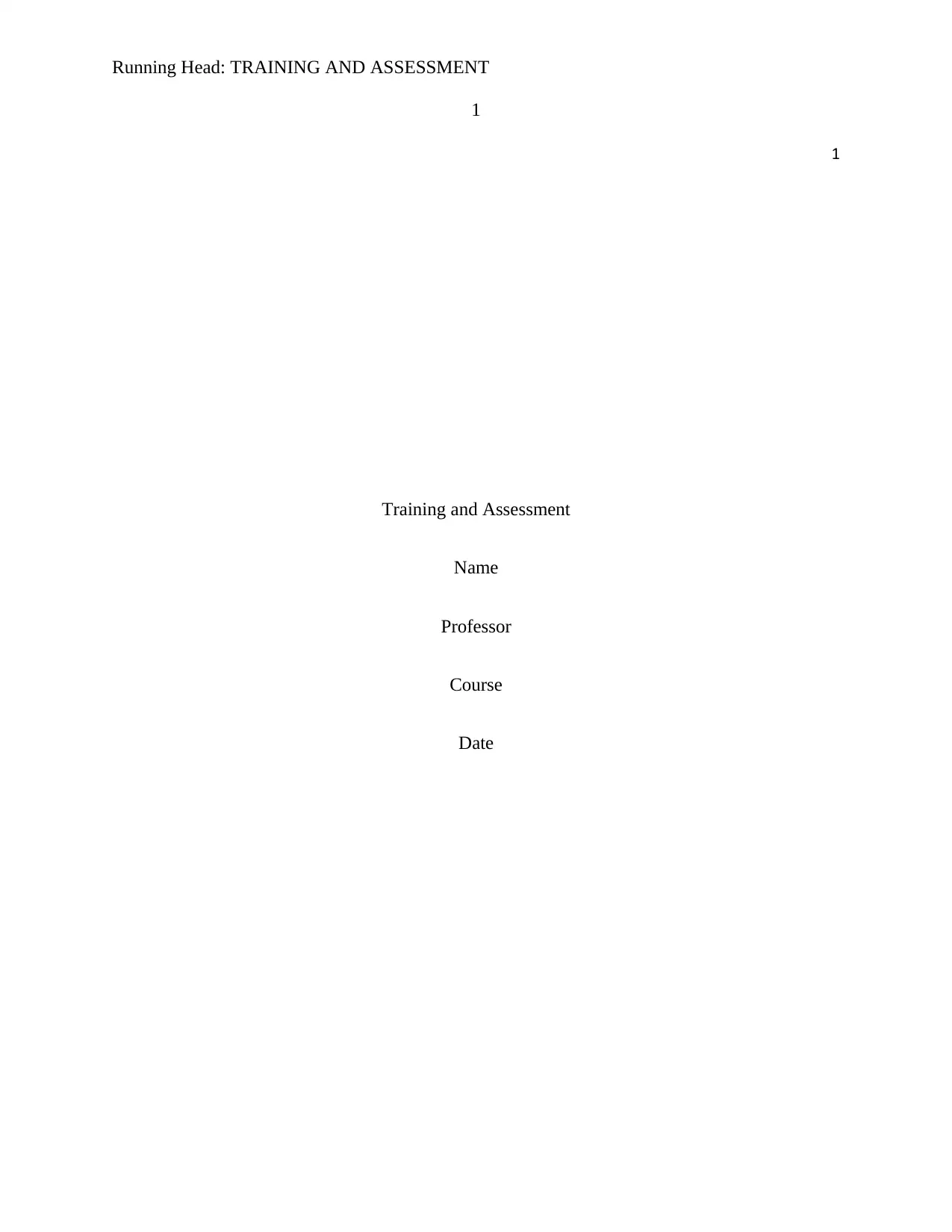
Running Head: TRAINING AND ASSESSMENT
1
1
Training and Assessment
Name
Professor
Course
Date
1
1
Training and Assessment
Name
Professor
Course
Date
Secure Best Marks with AI Grader
Need help grading? Try our AI Grader for instant feedback on your assignments.
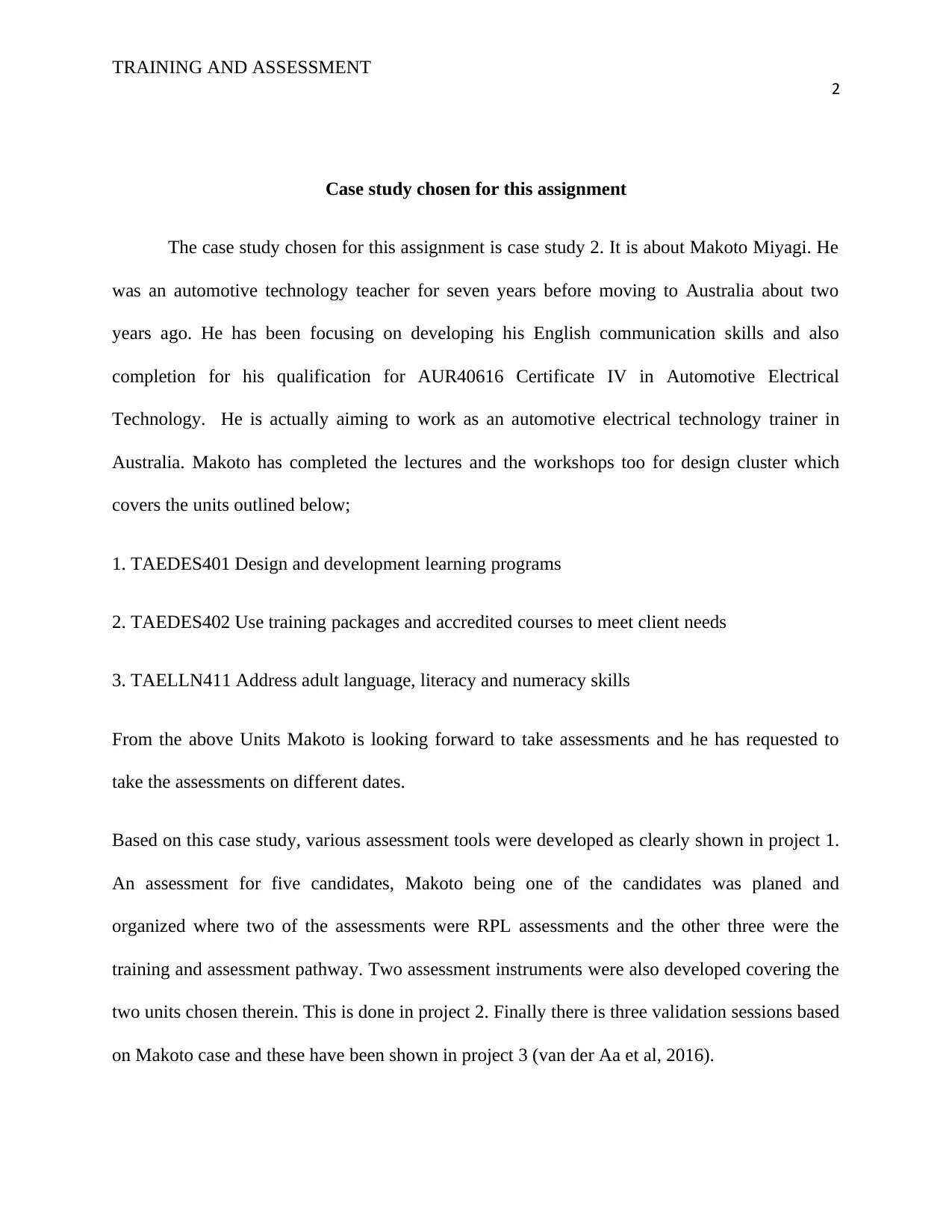
TRAINING AND ASSESSMENT
2
Case study chosen for this assignment
The case study chosen for this assignment is case study 2. It is about Makoto Miyagi. He
was an automotive technology teacher for seven years before moving to Australia about two
years ago. He has been focusing on developing his English communication skills and also
completion for his qualification for AUR40616 Certificate IV in Automotive Electrical
Technology. He is actually aiming to work as an automotive electrical technology trainer in
Australia. Makoto has completed the lectures and the workshops too for design cluster which
covers the units outlined below;
1. TAEDES401 Design and development learning programs
2. TAEDES402 Use training packages and accredited courses to meet client needs
3. TAELLN411 Address adult language, literacy and numeracy skills
From the above Units Makoto is looking forward to take assessments and he has requested to
take the assessments on different dates.
Based on this case study, various assessment tools were developed as clearly shown in project 1.
An assessment for five candidates, Makoto being one of the candidates was planed and
organized where two of the assessments were RPL assessments and the other three were the
training and assessment pathway. Two assessment instruments were also developed covering the
two units chosen therein. This is done in project 2. Finally there is three validation sessions based
on Makoto case and these have been shown in project 3 (van der Aa et al, 2016).
2
Case study chosen for this assignment
The case study chosen for this assignment is case study 2. It is about Makoto Miyagi. He
was an automotive technology teacher for seven years before moving to Australia about two
years ago. He has been focusing on developing his English communication skills and also
completion for his qualification for AUR40616 Certificate IV in Automotive Electrical
Technology. He is actually aiming to work as an automotive electrical technology trainer in
Australia. Makoto has completed the lectures and the workshops too for design cluster which
covers the units outlined below;
1. TAEDES401 Design and development learning programs
2. TAEDES402 Use training packages and accredited courses to meet client needs
3. TAELLN411 Address adult language, literacy and numeracy skills
From the above Units Makoto is looking forward to take assessments and he has requested to
take the assessments on different dates.
Based on this case study, various assessment tools were developed as clearly shown in project 1.
An assessment for five candidates, Makoto being one of the candidates was planed and
organized where two of the assessments were RPL assessments and the other three were the
training and assessment pathway. Two assessment instruments were also developed covering the
two units chosen therein. This is done in project 2. Finally there is three validation sessions based
on Makoto case and these have been shown in project 3 (van der Aa et al, 2016).
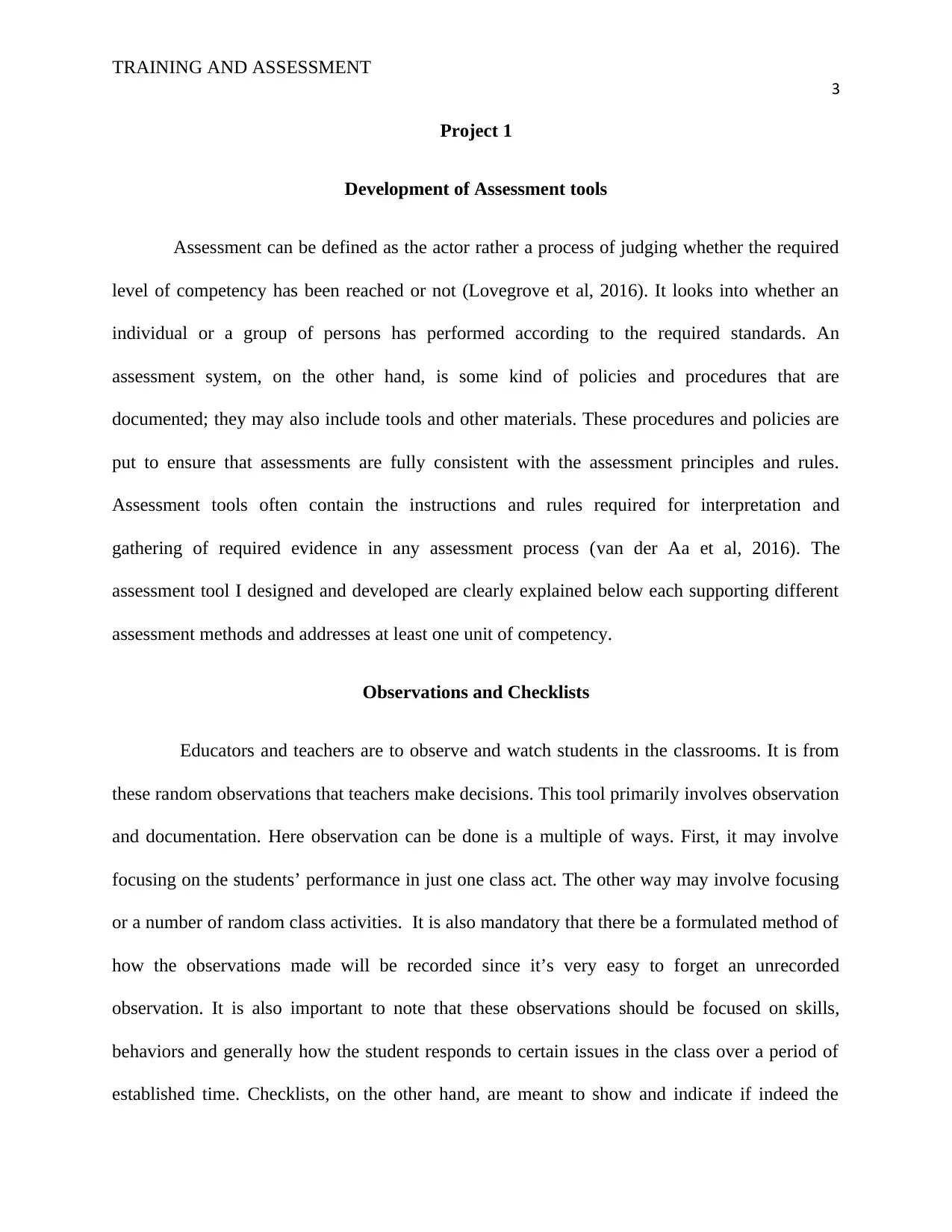
TRAINING AND ASSESSMENT
3
Project 1
Development of Assessment tools
Assessment can be defined as the actor rather a process of judging whether the required
level of competency has been reached or not (Lovegrove et al, 2016). It looks into whether an
individual or a group of persons has performed according to the required standards. An
assessment system, on the other hand, is some kind of policies and procedures that are
documented; they may also include tools and other materials. These procedures and policies are
put to ensure that assessments are fully consistent with the assessment principles and rules.
Assessment tools often contain the instructions and rules required for interpretation and
gathering of required evidence in any assessment process (van der Aa et al, 2016). The
assessment tool I designed and developed are clearly explained below each supporting different
assessment methods and addresses at least one unit of competency.
Observations and Checklists
Educators and teachers are to observe and watch students in the classrooms. It is from
these random observations that teachers make decisions. This tool primarily involves observation
and documentation. Here observation can be done is a multiple of ways. First, it may involve
focusing on the students’ performance in just one class act. The other way may involve focusing
or a number of random class activities. It is also mandatory that there be a formulated method of
how the observations made will be recorded since it’s very easy to forget an unrecorded
observation. It is also important to note that these observations should be focused on skills,
behaviors and generally how the student responds to certain issues in the class over a period of
established time. Checklists, on the other hand, are meant to show and indicate if indeed the
3
Project 1
Development of Assessment tools
Assessment can be defined as the actor rather a process of judging whether the required
level of competency has been reached or not (Lovegrove et al, 2016). It looks into whether an
individual or a group of persons has performed according to the required standards. An
assessment system, on the other hand, is some kind of policies and procedures that are
documented; they may also include tools and other materials. These procedures and policies are
put to ensure that assessments are fully consistent with the assessment principles and rules.
Assessment tools often contain the instructions and rules required for interpretation and
gathering of required evidence in any assessment process (van der Aa et al, 2016). The
assessment tool I designed and developed are clearly explained below each supporting different
assessment methods and addresses at least one unit of competency.
Observations and Checklists
Educators and teachers are to observe and watch students in the classrooms. It is from
these random observations that teachers make decisions. This tool primarily involves observation
and documentation. Here observation can be done is a multiple of ways. First, it may involve
focusing on the students’ performance in just one class act. The other way may involve focusing
or a number of random class activities. It is also mandatory that there be a formulated method of
how the observations made will be recorded since it’s very easy to forget an unrecorded
observation. It is also important to note that these observations should be focused on skills,
behaviors and generally how the student responds to certain issues in the class over a period of
established time. Checklists, on the other hand, are meant to show and indicate if indeed the
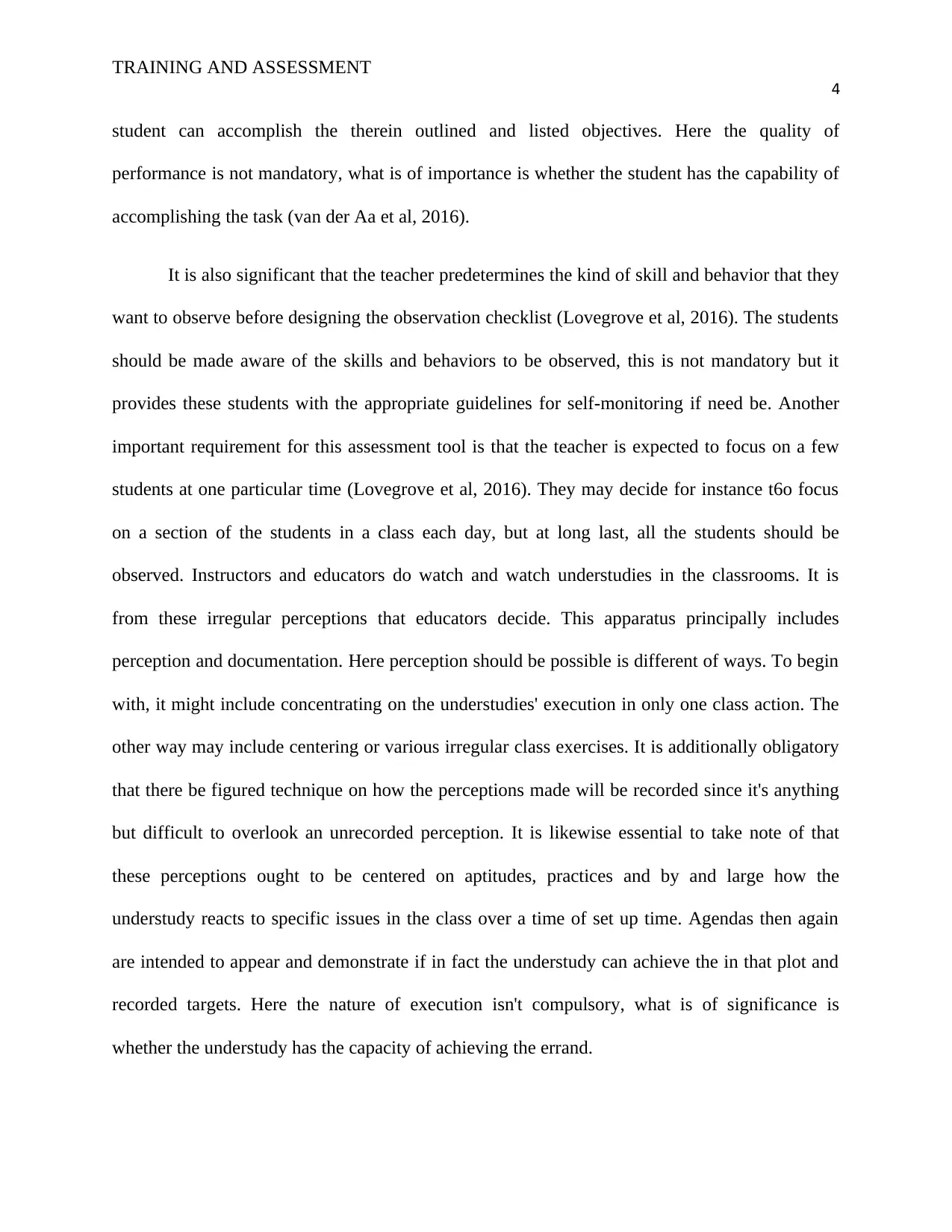
TRAINING AND ASSESSMENT
4
student can accomplish the therein outlined and listed objectives. Here the quality of
performance is not mandatory, what is of importance is whether the student has the capability of
accomplishing the task (van der Aa et al, 2016).
It is also significant that the teacher predetermines the kind of skill and behavior that they
want to observe before designing the observation checklist (Lovegrove et al, 2016). The students
should be made aware of the skills and behaviors to be observed, this is not mandatory but it
provides these students with the appropriate guidelines for self-monitoring if need be. Another
important requirement for this assessment tool is that the teacher is expected to focus on a few
students at one particular time (Lovegrove et al, 2016). They may decide for instance t6o focus
on a section of the students in a class each day, but at long last, all the students should be
observed. Instructors and educators do watch and watch understudies in the classrooms. It is
from these irregular perceptions that educators decide. This apparatus principally includes
perception and documentation. Here perception should be possible is different of ways. To begin
with, it might include concentrating on the understudies' execution in only one class action. The
other way may include centering or various irregular class exercises. It is additionally obligatory
that there be figured technique on how the perceptions made will be recorded since it's anything
but difficult to overlook an unrecorded perception. It is likewise essential to take note of that
these perceptions ought to be centered on aptitudes, practices and by and large how the
understudy reacts to specific issues in the class over a time of set up time. Agendas then again
are intended to appear and demonstrate if in fact the understudy can achieve the in that plot and
recorded targets. Here the nature of execution isn't compulsory, what is of significance is
whether the understudy has the capacity of achieving the errand.
4
student can accomplish the therein outlined and listed objectives. Here the quality of
performance is not mandatory, what is of importance is whether the student has the capability of
accomplishing the task (van der Aa et al, 2016).
It is also significant that the teacher predetermines the kind of skill and behavior that they
want to observe before designing the observation checklist (Lovegrove et al, 2016). The students
should be made aware of the skills and behaviors to be observed, this is not mandatory but it
provides these students with the appropriate guidelines for self-monitoring if need be. Another
important requirement for this assessment tool is that the teacher is expected to focus on a few
students at one particular time (Lovegrove et al, 2016). They may decide for instance t6o focus
on a section of the students in a class each day, but at long last, all the students should be
observed. Instructors and educators do watch and watch understudies in the classrooms. It is
from these irregular perceptions that educators decide. This apparatus principally includes
perception and documentation. Here perception should be possible is different of ways. To begin
with, it might include concentrating on the understudies' execution in only one class action. The
other way may include centering or various irregular class exercises. It is additionally obligatory
that there be figured technique on how the perceptions made will be recorded since it's anything
but difficult to overlook an unrecorded perception. It is likewise essential to take note of that
these perceptions ought to be centered on aptitudes, practices and by and large how the
understudy reacts to specific issues in the class over a time of set up time. Agendas then again
are intended to appear and demonstrate if in fact the understudy can achieve the in that plot and
recorded targets. Here the nature of execution isn't compulsory, what is of significance is
whether the understudy has the capacity of achieving the errand.
Secure Best Marks with AI Grader
Need help grading? Try our AI Grader for instant feedback on your assignments.
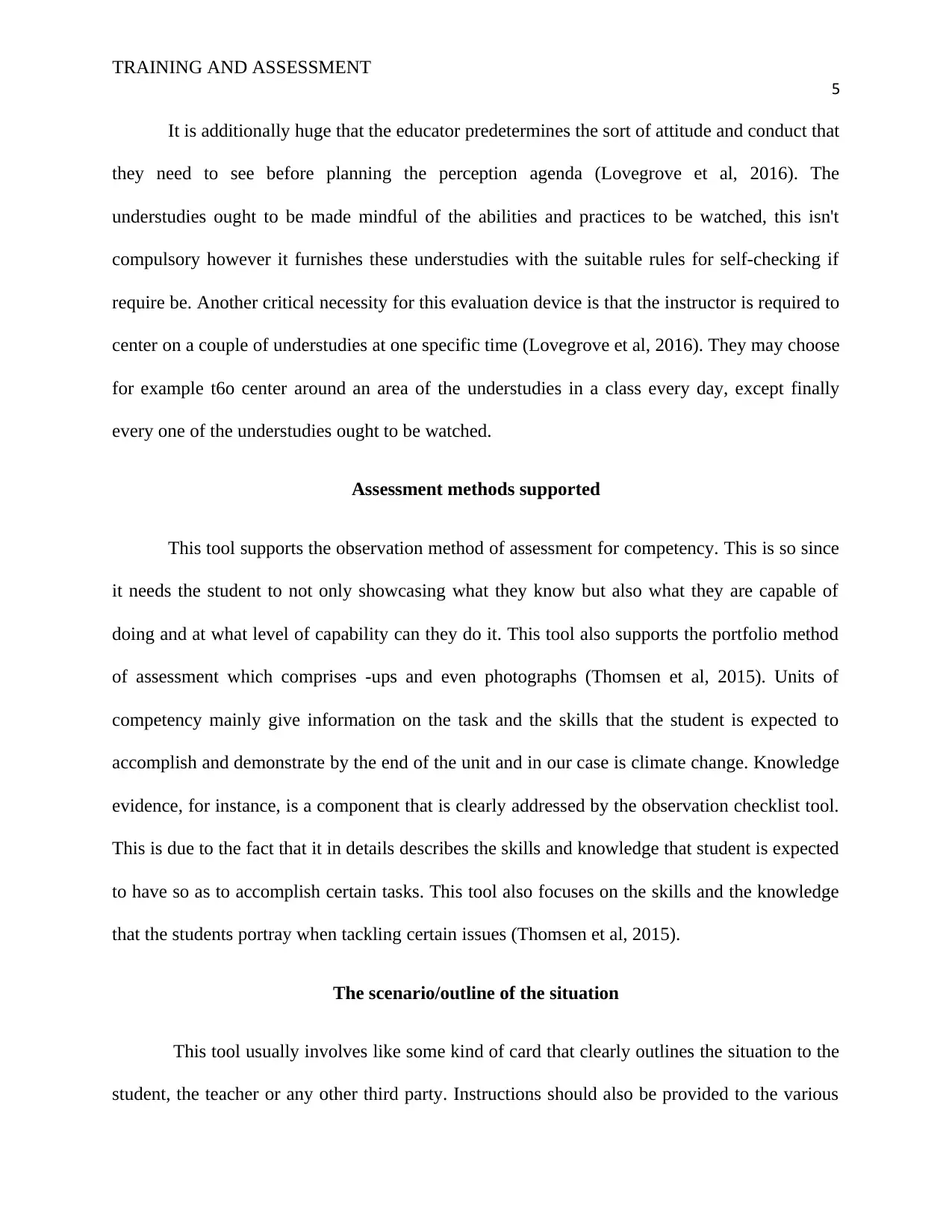
TRAINING AND ASSESSMENT
5
It is additionally huge that the educator predetermines the sort of attitude and conduct that
they need to see before planning the perception agenda (Lovegrove et al, 2016). The
understudies ought to be made mindful of the abilities and practices to be watched, this isn't
compulsory however it furnishes these understudies with the suitable rules for self-checking if
require be. Another critical necessity for this evaluation device is that the instructor is required to
center on a couple of understudies at one specific time (Lovegrove et al, 2016). They may choose
for example t6o center around an area of the understudies in a class every day, except finally
every one of the understudies ought to be watched.
Assessment methods supported
This tool supports the observation method of assessment for competency. This is so since
it needs the student to not only showcasing what they know but also what they are capable of
doing and at what level of capability can they do it. This tool also supports the portfolio method
of assessment which comprises -ups and even photographs (Thomsen et al, 2015). Units of
competency mainly give information on the task and the skills that the student is expected to
accomplish and demonstrate by the end of the unit and in our case is climate change. Knowledge
evidence, for instance, is a component that is clearly addressed by the observation checklist tool.
This is due to the fact that it in details describes the skills and knowledge that student is expected
to have so as to accomplish certain tasks. This tool also focuses on the skills and the knowledge
that the students portray when tackling certain issues (Thomsen et al, 2015).
The scenario/outline of the situation
This tool usually involves like some kind of card that clearly outlines the situation to the
student, the teacher or any other third party. Instructions should also be provided to the various
5
It is additionally huge that the educator predetermines the sort of attitude and conduct that
they need to see before planning the perception agenda (Lovegrove et al, 2016). The
understudies ought to be made mindful of the abilities and practices to be watched, this isn't
compulsory however it furnishes these understudies with the suitable rules for self-checking if
require be. Another critical necessity for this evaluation device is that the instructor is required to
center on a couple of understudies at one specific time (Lovegrove et al, 2016). They may choose
for example t6o center around an area of the understudies in a class every day, except finally
every one of the understudies ought to be watched.
Assessment methods supported
This tool supports the observation method of assessment for competency. This is so since
it needs the student to not only showcasing what they know but also what they are capable of
doing and at what level of capability can they do it. This tool also supports the portfolio method
of assessment which comprises -ups and even photographs (Thomsen et al, 2015). Units of
competency mainly give information on the task and the skills that the student is expected to
accomplish and demonstrate by the end of the unit and in our case is climate change. Knowledge
evidence, for instance, is a component that is clearly addressed by the observation checklist tool.
This is due to the fact that it in details describes the skills and knowledge that student is expected
to have so as to accomplish certain tasks. This tool also focuses on the skills and the knowledge
that the students portray when tackling certain issues (Thomsen et al, 2015).
The scenario/outline of the situation
This tool usually involves like some kind of card that clearly outlines the situation to the
student, the teacher or any other third party. Instructions should also be provided to the various
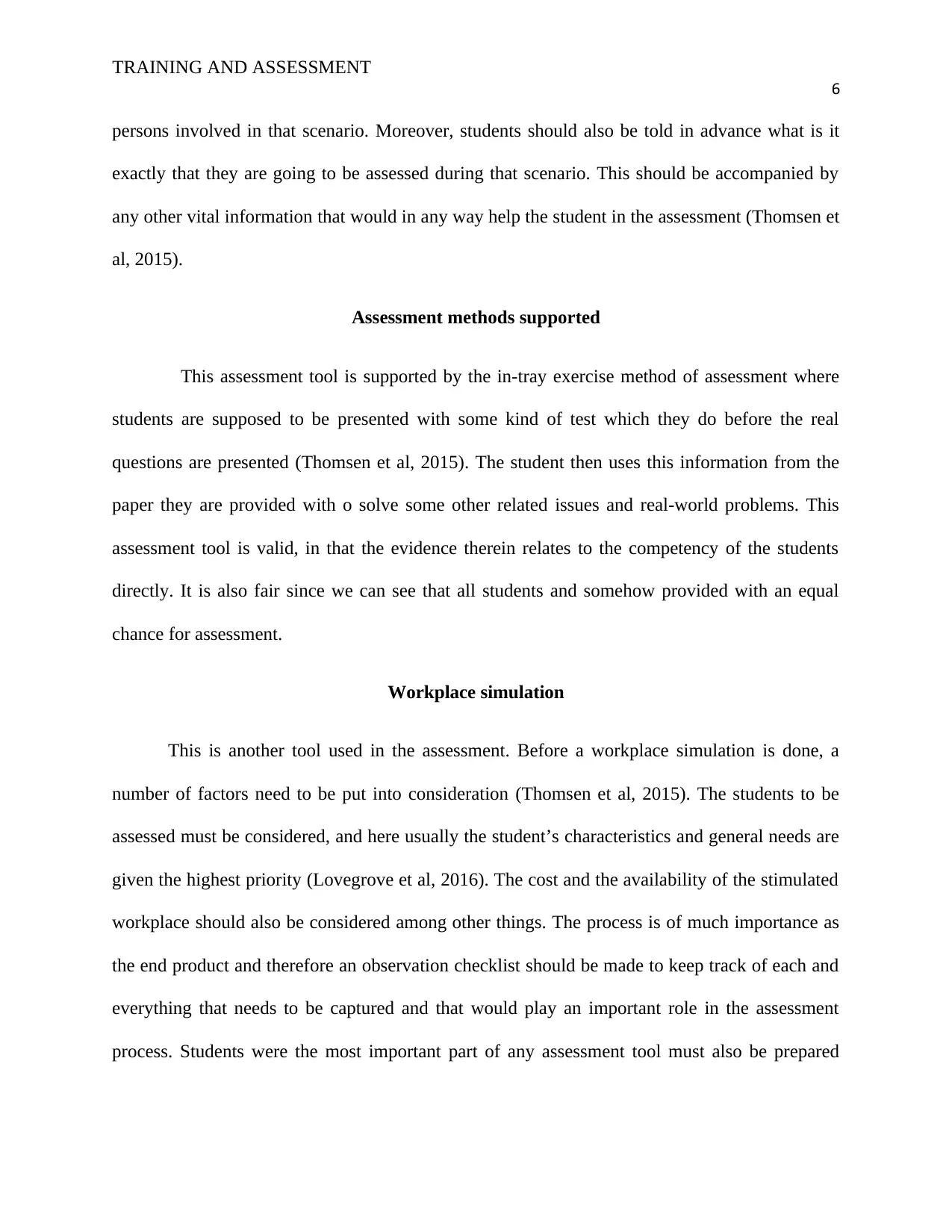
TRAINING AND ASSESSMENT
6
persons involved in that scenario. Moreover, students should also be told in advance what is it
exactly that they are going to be assessed during that scenario. This should be accompanied by
any other vital information that would in any way help the student in the assessment (Thomsen et
al, 2015).
Assessment methods supported
This assessment tool is supported by the in-tray exercise method of assessment where
students are supposed to be presented with some kind of test which they do before the real
questions are presented (Thomsen et al, 2015). The student then uses this information from the
paper they are provided with o solve some other related issues and real-world problems. This
assessment tool is valid, in that the evidence therein relates to the competency of the students
directly. It is also fair since we can see that all students and somehow provided with an equal
chance for assessment.
Workplace simulation
This is another tool used in the assessment. Before a workplace simulation is done, a
number of factors need to be put into consideration (Thomsen et al, 2015). The students to be
assessed must be considered, and here usually the student’s characteristics and general needs are
given the highest priority (Lovegrove et al, 2016). The cost and the availability of the stimulated
workplace should also be considered among other things. The process is of much importance as
the end product and therefore an observation checklist should be made to keep track of each and
everything that needs to be captured and that would play an important role in the assessment
process. Students were the most important part of any assessment tool must also be prepared
6
persons involved in that scenario. Moreover, students should also be told in advance what is it
exactly that they are going to be assessed during that scenario. This should be accompanied by
any other vital information that would in any way help the student in the assessment (Thomsen et
al, 2015).
Assessment methods supported
This assessment tool is supported by the in-tray exercise method of assessment where
students are supposed to be presented with some kind of test which they do before the real
questions are presented (Thomsen et al, 2015). The student then uses this information from the
paper they are provided with o solve some other related issues and real-world problems. This
assessment tool is valid, in that the evidence therein relates to the competency of the students
directly. It is also fair since we can see that all students and somehow provided with an equal
chance for assessment.
Workplace simulation
This is another tool used in the assessment. Before a workplace simulation is done, a
number of factors need to be put into consideration (Thomsen et al, 2015). The students to be
assessed must be considered, and here usually the student’s characteristics and general needs are
given the highest priority (Lovegrove et al, 2016). The cost and the availability of the stimulated
workplace should also be considered among other things. The process is of much importance as
the end product and therefore an observation checklist should be made to keep track of each and
everything that needs to be captured and that would play an important role in the assessment
process. Students were the most important part of any assessment tool must also be prepared
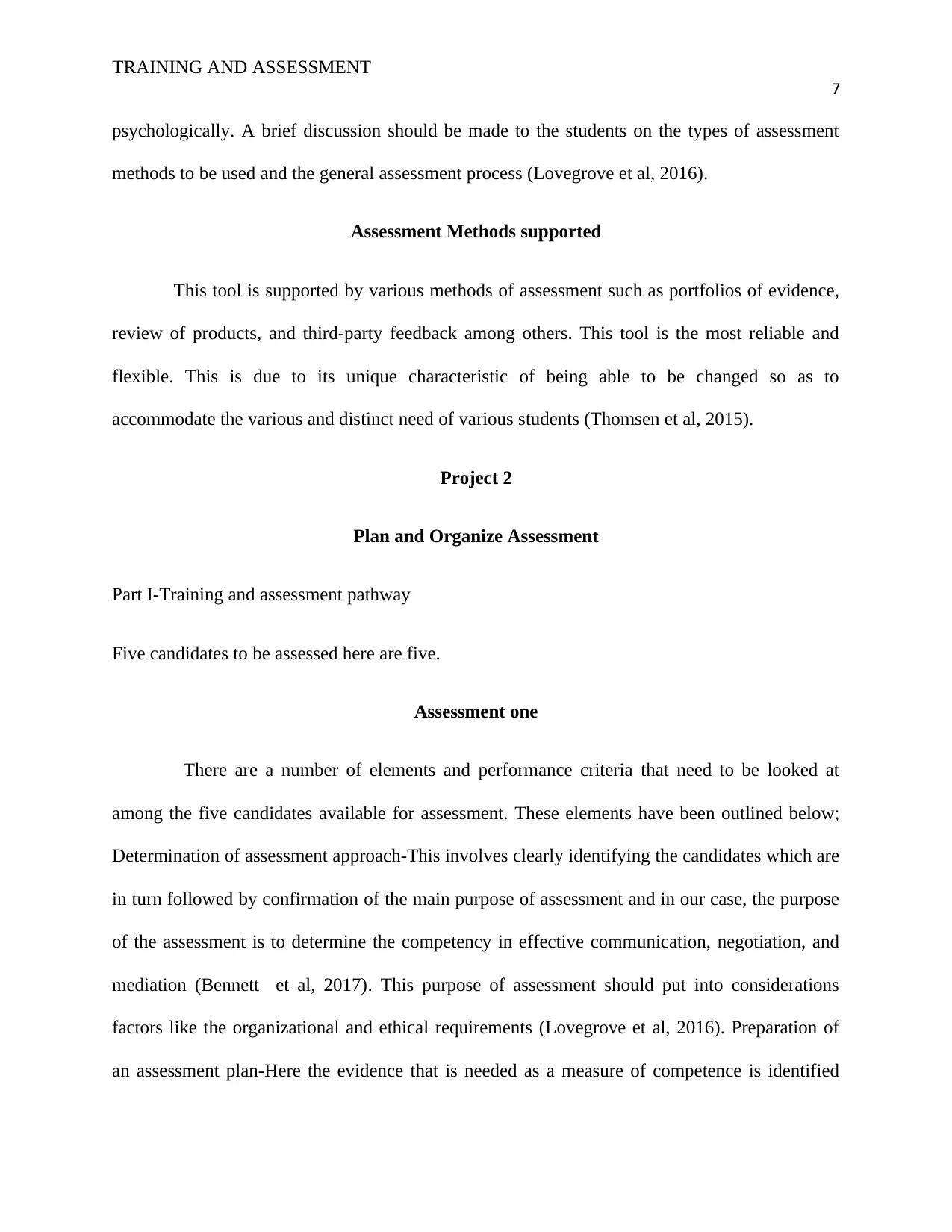
TRAINING AND ASSESSMENT
7
psychologically. A brief discussion should be made to the students on the types of assessment
methods to be used and the general assessment process (Lovegrove et al, 2016).
Assessment Methods supported
This tool is supported by various methods of assessment such as portfolios of evidence,
review of products, and third-party feedback among others. This tool is the most reliable and
flexible. This is due to its unique characteristic of being able to be changed so as to
accommodate the various and distinct need of various students (Thomsen et al, 2015).
Project 2
Plan and Organize Assessment
Part I-Training and assessment pathway
Five candidates to be assessed here are five.
Assessment one
There are a number of elements and performance criteria that need to be looked at
among the five candidates available for assessment. These elements have been outlined below;
Determination of assessment approach-This involves clearly identifying the candidates which are
in turn followed by confirmation of the main purpose of assessment and in our case, the purpose
of the assessment is to determine the competency in effective communication, negotiation, and
mediation (Bennett et al, 2017). This purpose of assessment should put into considerations
factors like the organizational and ethical requirements (Lovegrove et al, 2016). Preparation of
an assessment plan-Here the evidence that is needed as a measure of competence is identified
7
psychologically. A brief discussion should be made to the students on the types of assessment
methods to be used and the general assessment process (Lovegrove et al, 2016).
Assessment Methods supported
This tool is supported by various methods of assessment such as portfolios of evidence,
review of products, and third-party feedback among others. This tool is the most reliable and
flexible. This is due to its unique characteristic of being able to be changed so as to
accommodate the various and distinct need of various students (Thomsen et al, 2015).
Project 2
Plan and Organize Assessment
Part I-Training and assessment pathway
Five candidates to be assessed here are five.
Assessment one
There are a number of elements and performance criteria that need to be looked at
among the five candidates available for assessment. These elements have been outlined below;
Determination of assessment approach-This involves clearly identifying the candidates which are
in turn followed by confirmation of the main purpose of assessment and in our case, the purpose
of the assessment is to determine the competency in effective communication, negotiation, and
mediation (Bennett et al, 2017). This purpose of assessment should put into considerations
factors like the organizational and ethical requirements (Lovegrove et al, 2016). Preparation of
an assessment plan-Here the evidence that is needed as a measure of competence is identified
Paraphrase This Document
Need a fresh take? Get an instant paraphrase of this document with our AI Paraphraser
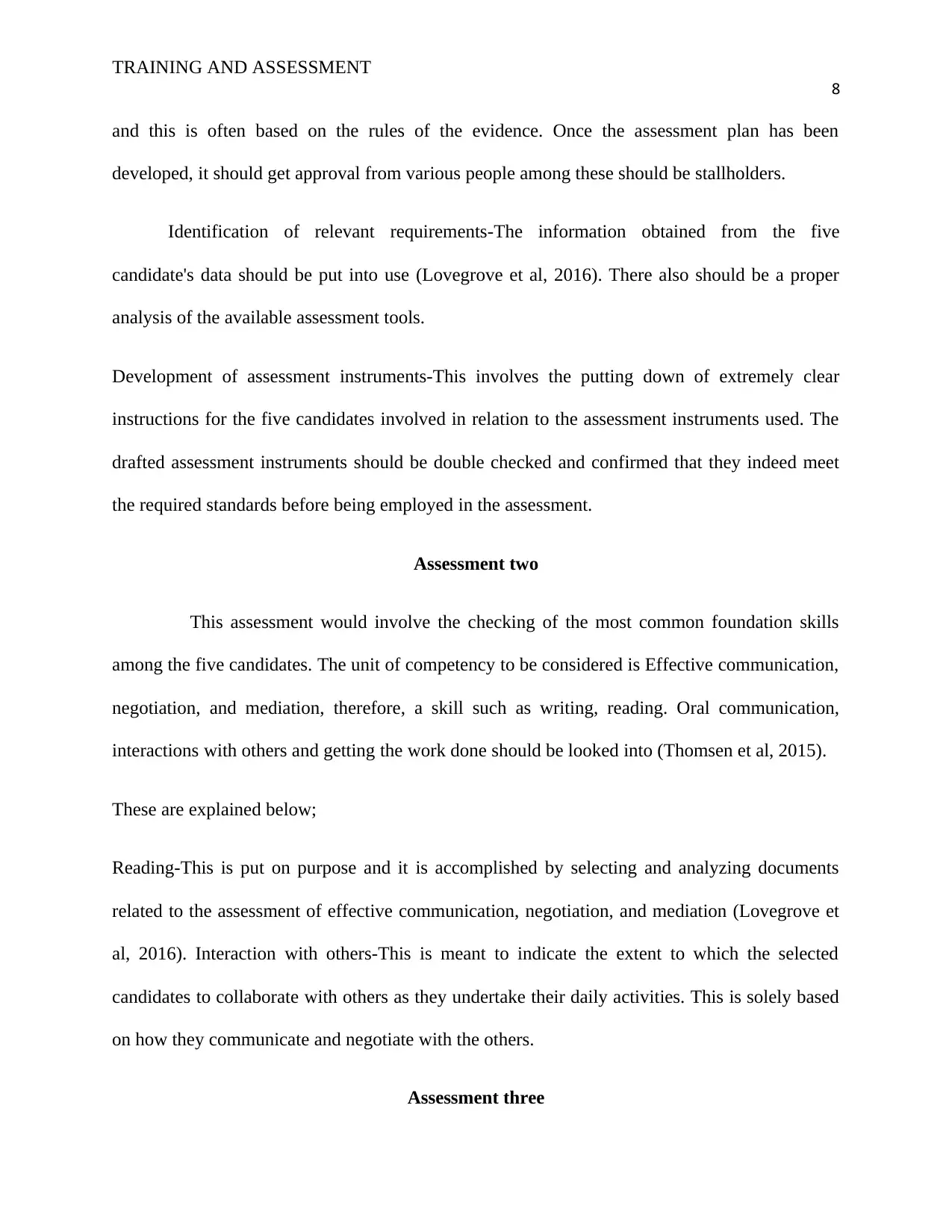
TRAINING AND ASSESSMENT
8
and this is often based on the rules of the evidence. Once the assessment plan has been
developed, it should get approval from various people among these should be stallholders.
Identification of relevant requirements-The information obtained from the five
candidate's data should be put into use (Lovegrove et al, 2016). There also should be a proper
analysis of the available assessment tools.
Development of assessment instruments-This involves the putting down of extremely clear
instructions for the five candidates involved in relation to the assessment instruments used. The
drafted assessment instruments should be double checked and confirmed that they indeed meet
the required standards before being employed in the assessment.
Assessment two
This assessment would involve the checking of the most common foundation skills
among the five candidates. The unit of competency to be considered is Effective communication,
negotiation, and mediation, therefore, a skill such as writing, reading. Oral communication,
interactions with others and getting the work done should be looked into (Thomsen et al, 2015).
These are explained below;
Reading-This is put on purpose and it is accomplished by selecting and analyzing documents
related to the assessment of effective communication, negotiation, and mediation (Lovegrove et
al, 2016). Interaction with others-This is meant to indicate the extent to which the selected
candidates to collaborate with others as they undertake their daily activities. This is solely based
on how they communicate and negotiate with the others.
Assessment three
8
and this is often based on the rules of the evidence. Once the assessment plan has been
developed, it should get approval from various people among these should be stallholders.
Identification of relevant requirements-The information obtained from the five
candidate's data should be put into use (Lovegrove et al, 2016). There also should be a proper
analysis of the available assessment tools.
Development of assessment instruments-This involves the putting down of extremely clear
instructions for the five candidates involved in relation to the assessment instruments used. The
drafted assessment instruments should be double checked and confirmed that they indeed meet
the required standards before being employed in the assessment.
Assessment two
This assessment would involve the checking of the most common foundation skills
among the five candidates. The unit of competency to be considered is Effective communication,
negotiation, and mediation, therefore, a skill such as writing, reading. Oral communication,
interactions with others and getting the work done should be looked into (Thomsen et al, 2015).
These are explained below;
Reading-This is put on purpose and it is accomplished by selecting and analyzing documents
related to the assessment of effective communication, negotiation, and mediation (Lovegrove et
al, 2016). Interaction with others-This is meant to indicate the extent to which the selected
candidates to collaborate with others as they undertake their daily activities. This is solely based
on how they communicate and negotiate with the others.
Assessment three
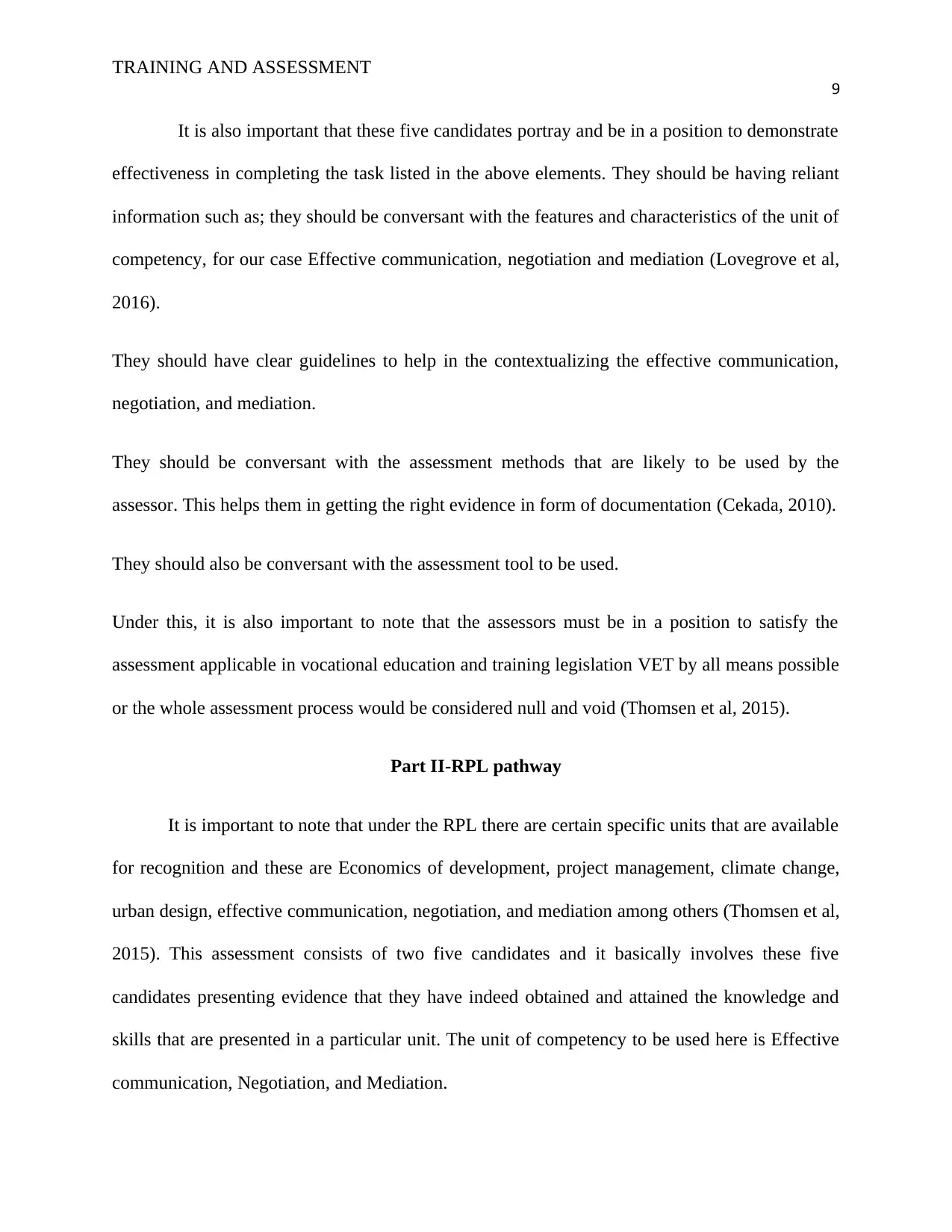
TRAINING AND ASSESSMENT
9
It is also important that these five candidates portray and be in a position to demonstrate
effectiveness in completing the task listed in the above elements. They should be having reliant
information such as; they should be conversant with the features and characteristics of the unit of
competency, for our case Effective communication, negotiation and mediation (Lovegrove et al,
2016).
They should have clear guidelines to help in the contextualizing the effective communication,
negotiation, and mediation.
They should be conversant with the assessment methods that are likely to be used by the
assessor. This helps them in getting the right evidence in form of documentation (Cekada, 2010).
They should also be conversant with the assessment tool to be used.
Under this, it is also important to note that the assessors must be in a position to satisfy the
assessment applicable in vocational education and training legislation VET by all means possible
or the whole assessment process would be considered null and void (Thomsen et al, 2015).
Part II-RPL pathway
It is important to note that under the RPL there are certain specific units that are available
for recognition and these are Economics of development, project management, climate change,
urban design, effective communication, negotiation, and mediation among others (Thomsen et al,
2015). This assessment consists of two five candidates and it basically involves these five
candidates presenting evidence that they have indeed obtained and attained the knowledge and
skills that are presented in a particular unit. The unit of competency to be used here is Effective
communication, Negotiation, and Mediation.
9
It is also important that these five candidates portray and be in a position to demonstrate
effectiveness in completing the task listed in the above elements. They should be having reliant
information such as; they should be conversant with the features and characteristics of the unit of
competency, for our case Effective communication, negotiation and mediation (Lovegrove et al,
2016).
They should have clear guidelines to help in the contextualizing the effective communication,
negotiation, and mediation.
They should be conversant with the assessment methods that are likely to be used by the
assessor. This helps them in getting the right evidence in form of documentation (Cekada, 2010).
They should also be conversant with the assessment tool to be used.
Under this, it is also important to note that the assessors must be in a position to satisfy the
assessment applicable in vocational education and training legislation VET by all means possible
or the whole assessment process would be considered null and void (Thomsen et al, 2015).
Part II-RPL pathway
It is important to note that under the RPL there are certain specific units that are available
for recognition and these are Economics of development, project management, climate change,
urban design, effective communication, negotiation, and mediation among others (Thomsen et al,
2015). This assessment consists of two five candidates and it basically involves these five
candidates presenting evidence that they have indeed obtained and attained the knowledge and
skills that are presented in a particular unit. The unit of competency to be used here is Effective
communication, Negotiation, and Mediation.
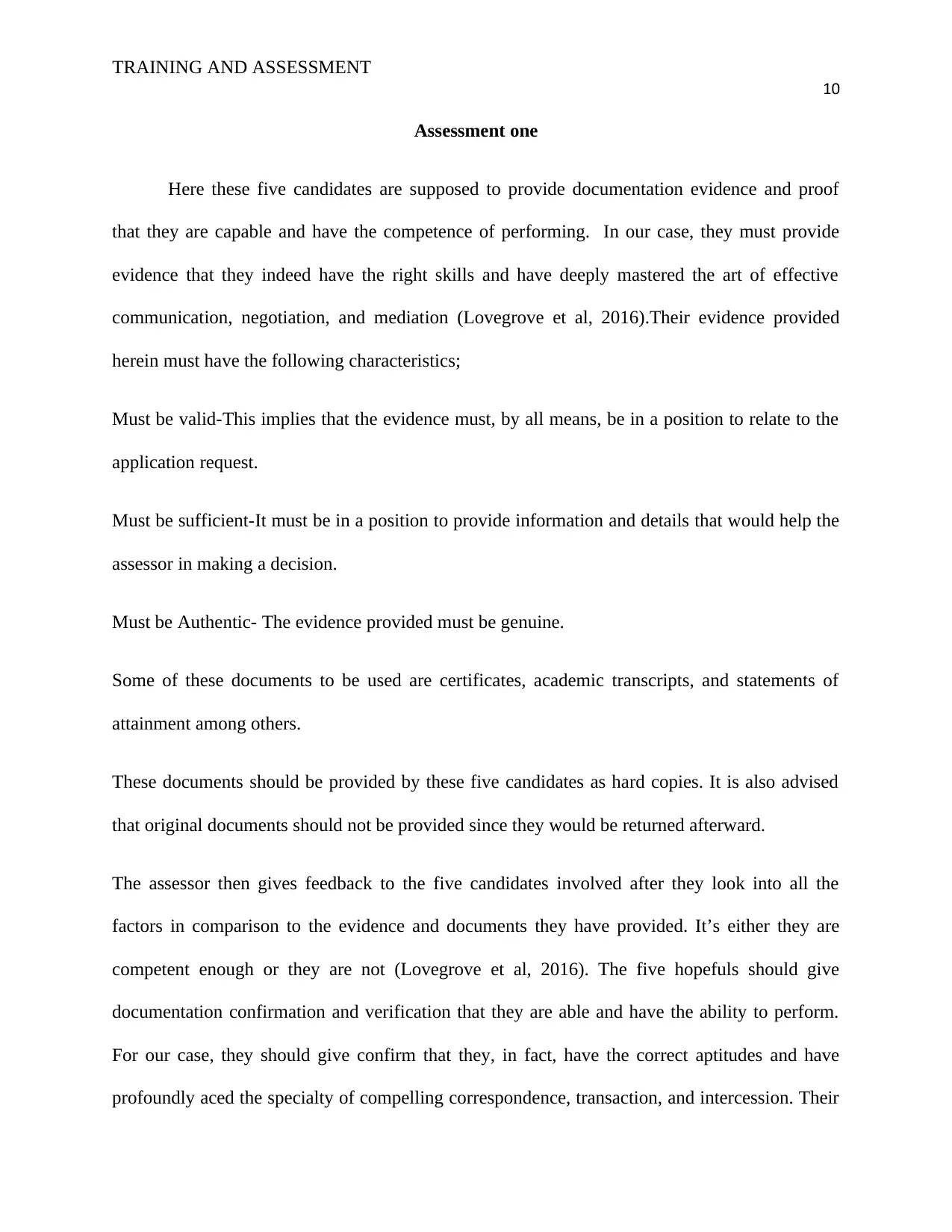
TRAINING AND ASSESSMENT
10
Assessment one
Here these five candidates are supposed to provide documentation evidence and proof
that they are capable and have the competence of performing. In our case, they must provide
evidence that they indeed have the right skills and have deeply mastered the art of effective
communication, negotiation, and mediation (Lovegrove et al, 2016).Their evidence provided
herein must have the following characteristics;
Must be valid-This implies that the evidence must, by all means, be in a position to relate to the
application request.
Must be sufficient-It must be in a position to provide information and details that would help the
assessor in making a decision.
Must be Authentic- The evidence provided must be genuine.
Some of these documents to be used are certificates, academic transcripts, and statements of
attainment among others.
These documents should be provided by these five candidates as hard copies. It is also advised
that original documents should not be provided since they would be returned afterward.
The assessor then gives feedback to the five candidates involved after they look into all the
factors in comparison to the evidence and documents they have provided. It’s either they are
competent enough or they are not (Lovegrove et al, 2016). The five hopefuls should give
documentation confirmation and verification that they are able and have the ability to perform.
For our case, they should give confirm that they, in fact, have the correct aptitudes and have
profoundly aced the specialty of compelling correspondence, transaction, and intercession. Their
10
Assessment one
Here these five candidates are supposed to provide documentation evidence and proof
that they are capable and have the competence of performing. In our case, they must provide
evidence that they indeed have the right skills and have deeply mastered the art of effective
communication, negotiation, and mediation (Lovegrove et al, 2016).Their evidence provided
herein must have the following characteristics;
Must be valid-This implies that the evidence must, by all means, be in a position to relate to the
application request.
Must be sufficient-It must be in a position to provide information and details that would help the
assessor in making a decision.
Must be Authentic- The evidence provided must be genuine.
Some of these documents to be used are certificates, academic transcripts, and statements of
attainment among others.
These documents should be provided by these five candidates as hard copies. It is also advised
that original documents should not be provided since they would be returned afterward.
The assessor then gives feedback to the five candidates involved after they look into all the
factors in comparison to the evidence and documents they have provided. It’s either they are
competent enough or they are not (Lovegrove et al, 2016). The five hopefuls should give
documentation confirmation and verification that they are able and have the ability to perform.
For our case, they should give confirm that they, in fact, have the correct aptitudes and have
profoundly aced the specialty of compelling correspondence, transaction, and intercession. Their
Secure Best Marks with AI Grader
Need help grading? Try our AI Grader for instant feedback on your assignments.
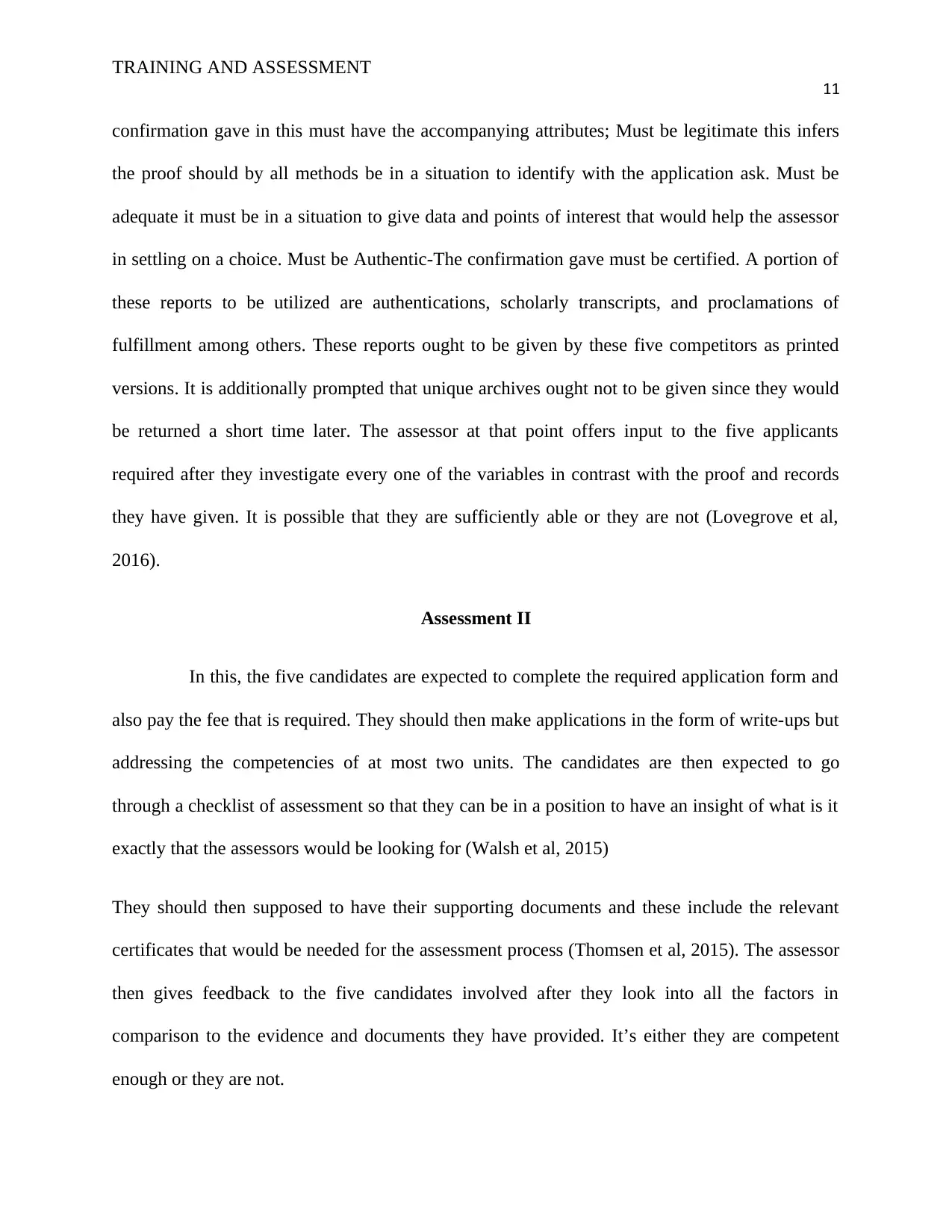
TRAINING AND ASSESSMENT
11
confirmation gave in this must have the accompanying attributes; Must be legitimate this infers
the proof should by all methods be in a situation to identify with the application ask. Must be
adequate it must be in a situation to give data and points of interest that would help the assessor
in settling on a choice. Must be Authentic-The confirmation gave must be certified. A portion of
these reports to be utilized are authentications, scholarly transcripts, and proclamations of
fulfillment among others. These reports ought to be given by these five competitors as printed
versions. It is additionally prompted that unique archives ought not to be given since they would
be returned a short time later. The assessor at that point offers input to the five applicants
required after they investigate every one of the variables in contrast with the proof and records
they have given. It is possible that they are sufficiently able or they are not (Lovegrove et al,
2016).
Assessment II
In this, the five candidates are expected to complete the required application form and
also pay the fee that is required. They should then make applications in the form of write-ups but
addressing the competencies of at most two units. The candidates are then expected to go
through a checklist of assessment so that they can be in a position to have an insight of what is it
exactly that the assessors would be looking for (Walsh et al, 2015)
They should then supposed to have their supporting documents and these include the relevant
certificates that would be needed for the assessment process (Thomsen et al, 2015). The assessor
then gives feedback to the five candidates involved after they look into all the factors in
comparison to the evidence and documents they have provided. It’s either they are competent
enough or they are not.
11
confirmation gave in this must have the accompanying attributes; Must be legitimate this infers
the proof should by all methods be in a situation to identify with the application ask. Must be
adequate it must be in a situation to give data and points of interest that would help the assessor
in settling on a choice. Must be Authentic-The confirmation gave must be certified. A portion of
these reports to be utilized are authentications, scholarly transcripts, and proclamations of
fulfillment among others. These reports ought to be given by these five competitors as printed
versions. It is additionally prompted that unique archives ought not to be given since they would
be returned a short time later. The assessor at that point offers input to the five applicants
required after they investigate every one of the variables in contrast with the proof and records
they have given. It is possible that they are sufficiently able or they are not (Lovegrove et al,
2016).
Assessment II
In this, the five candidates are expected to complete the required application form and
also pay the fee that is required. They should then make applications in the form of write-ups but
addressing the competencies of at most two units. The candidates are then expected to go
through a checklist of assessment so that they can be in a position to have an insight of what is it
exactly that the assessors would be looking for (Walsh et al, 2015)
They should then supposed to have their supporting documents and these include the relevant
certificates that would be needed for the assessment process (Thomsen et al, 2015). The assessor
then gives feedback to the five candidates involved after they look into all the factors in
comparison to the evidence and documents they have provided. It’s either they are competent
enough or they are not.
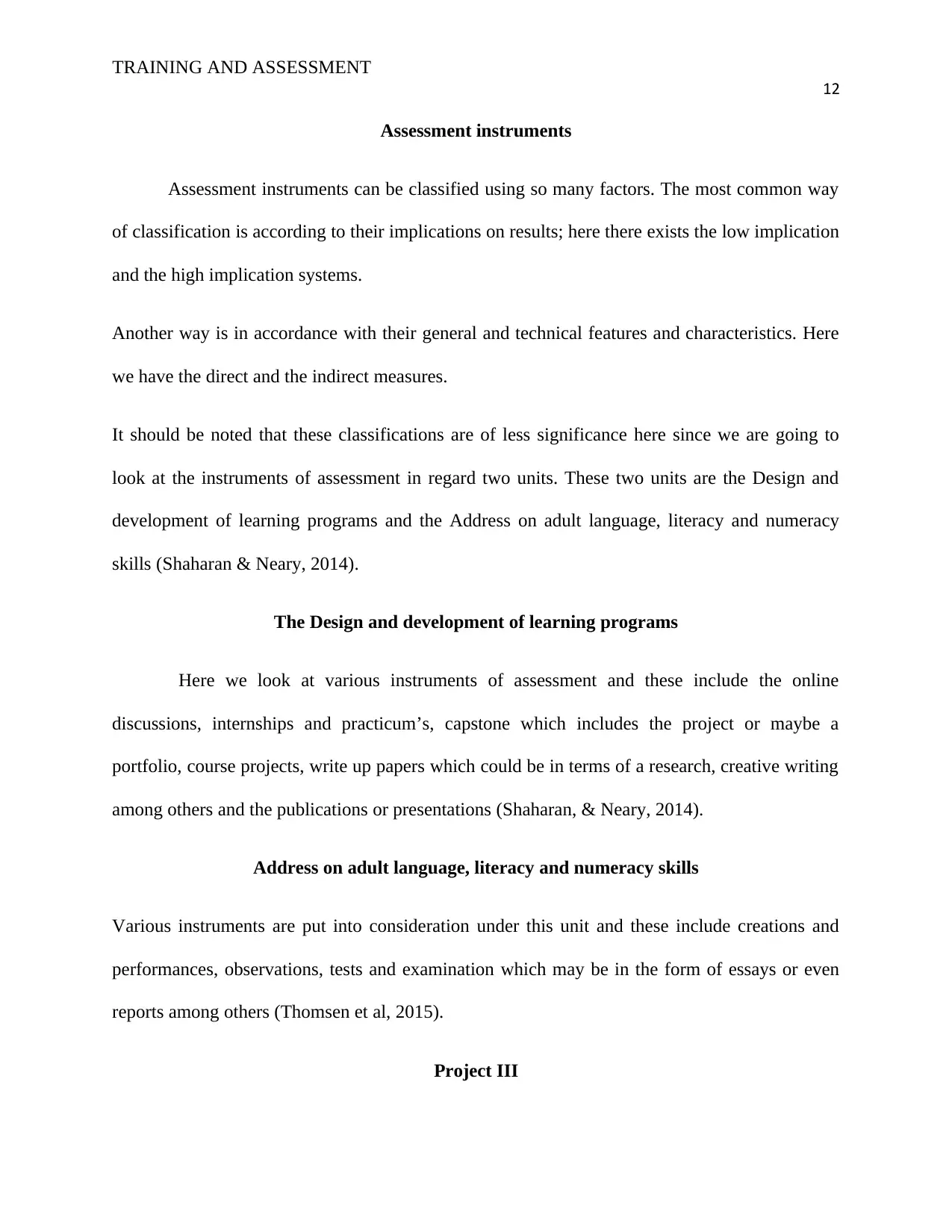
TRAINING AND ASSESSMENT
12
Assessment instruments
Assessment instruments can be classified using so many factors. The most common way
of classification is according to their implications on results; here there exists the low implication
and the high implication systems.
Another way is in accordance with their general and technical features and characteristics. Here
we have the direct and the indirect measures.
It should be noted that these classifications are of less significance here since we are going to
look at the instruments of assessment in regard two units. These two units are the Design and
development of learning programs and the Address on adult language, literacy and numeracy
skills (Shaharan & Neary, 2014).
The Design and development of learning programs
Here we look at various instruments of assessment and these include the online
discussions, internships and practicum’s, capstone which includes the project or maybe a
portfolio, course projects, write up papers which could be in terms of a research, creative writing
among others and the publications or presentations (Shaharan, & Neary, 2014).
Address on adult language, literacy and numeracy skills
Various instruments are put into consideration under this unit and these include creations and
performances, observations, tests and examination which may be in the form of essays or even
reports among others (Thomsen et al, 2015).
Project III
12
Assessment instruments
Assessment instruments can be classified using so many factors. The most common way
of classification is according to their implications on results; here there exists the low implication
and the high implication systems.
Another way is in accordance with their general and technical features and characteristics. Here
we have the direct and the indirect measures.
It should be noted that these classifications are of less significance here since we are going to
look at the instruments of assessment in regard two units. These two units are the Design and
development of learning programs and the Address on adult language, literacy and numeracy
skills (Shaharan & Neary, 2014).
The Design and development of learning programs
Here we look at various instruments of assessment and these include the online
discussions, internships and practicum’s, capstone which includes the project or maybe a
portfolio, course projects, write up papers which could be in terms of a research, creative writing
among others and the publications or presentations (Shaharan, & Neary, 2014).
Address on adult language, literacy and numeracy skills
Various instruments are put into consideration under this unit and these include creations and
performances, observations, tests and examination which may be in the form of essays or even
reports among others (Thomsen et al, 2015).
Project III
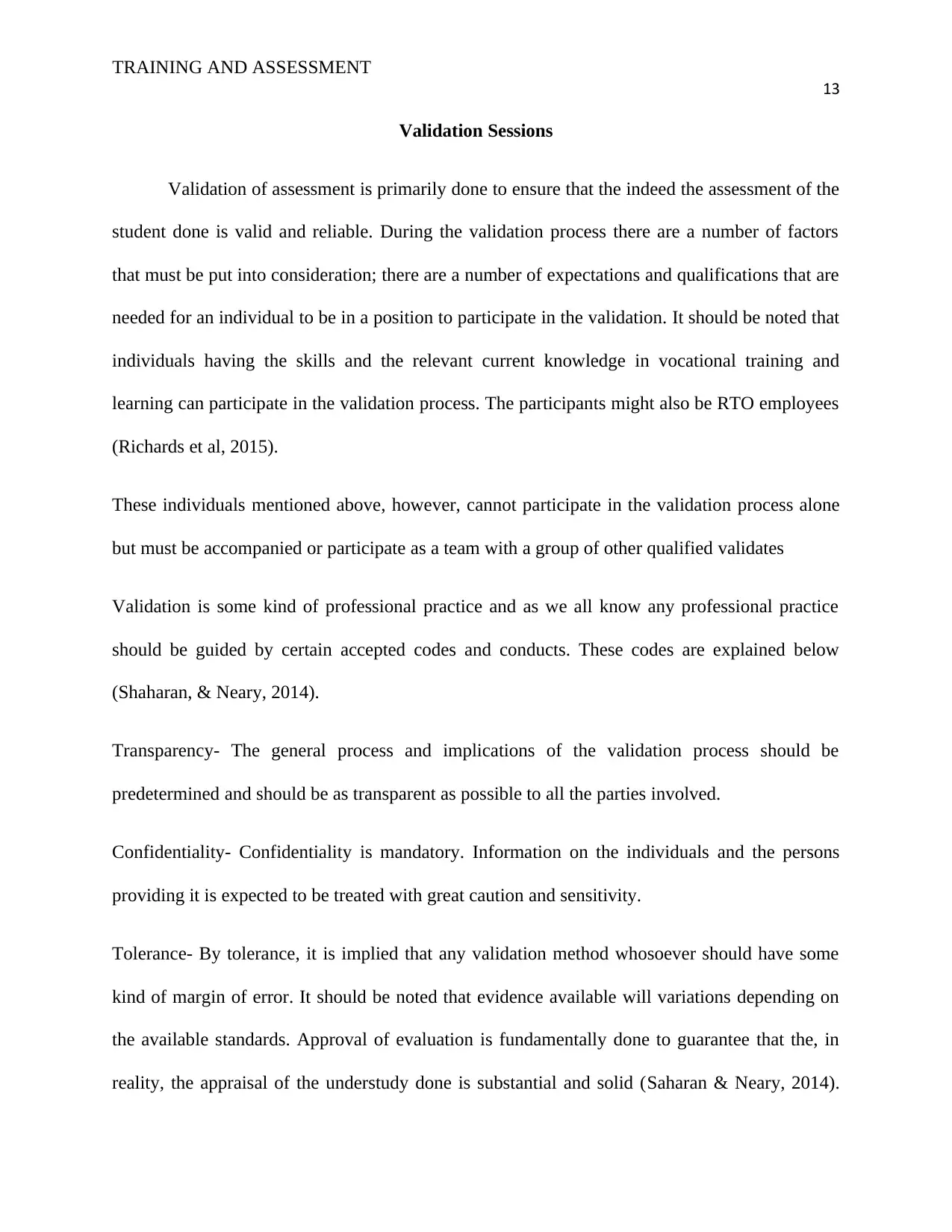
TRAINING AND ASSESSMENT
13
Validation Sessions
Validation of assessment is primarily done to ensure that the indeed the assessment of the
student done is valid and reliable. During the validation process there are a number of factors
that must be put into consideration; there are a number of expectations and qualifications that are
needed for an individual to be in a position to participate in the validation. It should be noted that
individuals having the skills and the relevant current knowledge in vocational training and
learning can participate in the validation process. The participants might also be RTO employees
(Richards et al, 2015).
These individuals mentioned above, however, cannot participate in the validation process alone
but must be accompanied or participate as a team with a group of other qualified validates
Validation is some kind of professional practice and as we all know any professional practice
should be guided by certain accepted codes and conducts. These codes are explained below
(Shaharan, & Neary, 2014).
Transparency- The general process and implications of the validation process should be
predetermined and should be as transparent as possible to all the parties involved.
Confidentiality- Confidentiality is mandatory. Information on the individuals and the persons
providing it is expected to be treated with great caution and sensitivity.
Tolerance- By tolerance, it is implied that any validation method whosoever should have some
kind of margin of error. It should be noted that evidence available will variations depending on
the available standards. Approval of evaluation is fundamentally done to guarantee that the, in
reality, the appraisal of the understudy done is substantial and solid (Saharan & Neary, 2014).
13
Validation Sessions
Validation of assessment is primarily done to ensure that the indeed the assessment of the
student done is valid and reliable. During the validation process there are a number of factors
that must be put into consideration; there are a number of expectations and qualifications that are
needed for an individual to be in a position to participate in the validation. It should be noted that
individuals having the skills and the relevant current knowledge in vocational training and
learning can participate in the validation process. The participants might also be RTO employees
(Richards et al, 2015).
These individuals mentioned above, however, cannot participate in the validation process alone
but must be accompanied or participate as a team with a group of other qualified validates
Validation is some kind of professional practice and as we all know any professional practice
should be guided by certain accepted codes and conducts. These codes are explained below
(Shaharan, & Neary, 2014).
Transparency- The general process and implications of the validation process should be
predetermined and should be as transparent as possible to all the parties involved.
Confidentiality- Confidentiality is mandatory. Information on the individuals and the persons
providing it is expected to be treated with great caution and sensitivity.
Tolerance- By tolerance, it is implied that any validation method whosoever should have some
kind of margin of error. It should be noted that evidence available will variations depending on
the available standards. Approval of evaluation is fundamentally done to guarantee that the, in
reality, the appraisal of the understudy done is substantial and solid (Saharan & Neary, 2014).
Paraphrase This Document
Need a fresh take? Get an instant paraphrase of this document with our AI Paraphraser
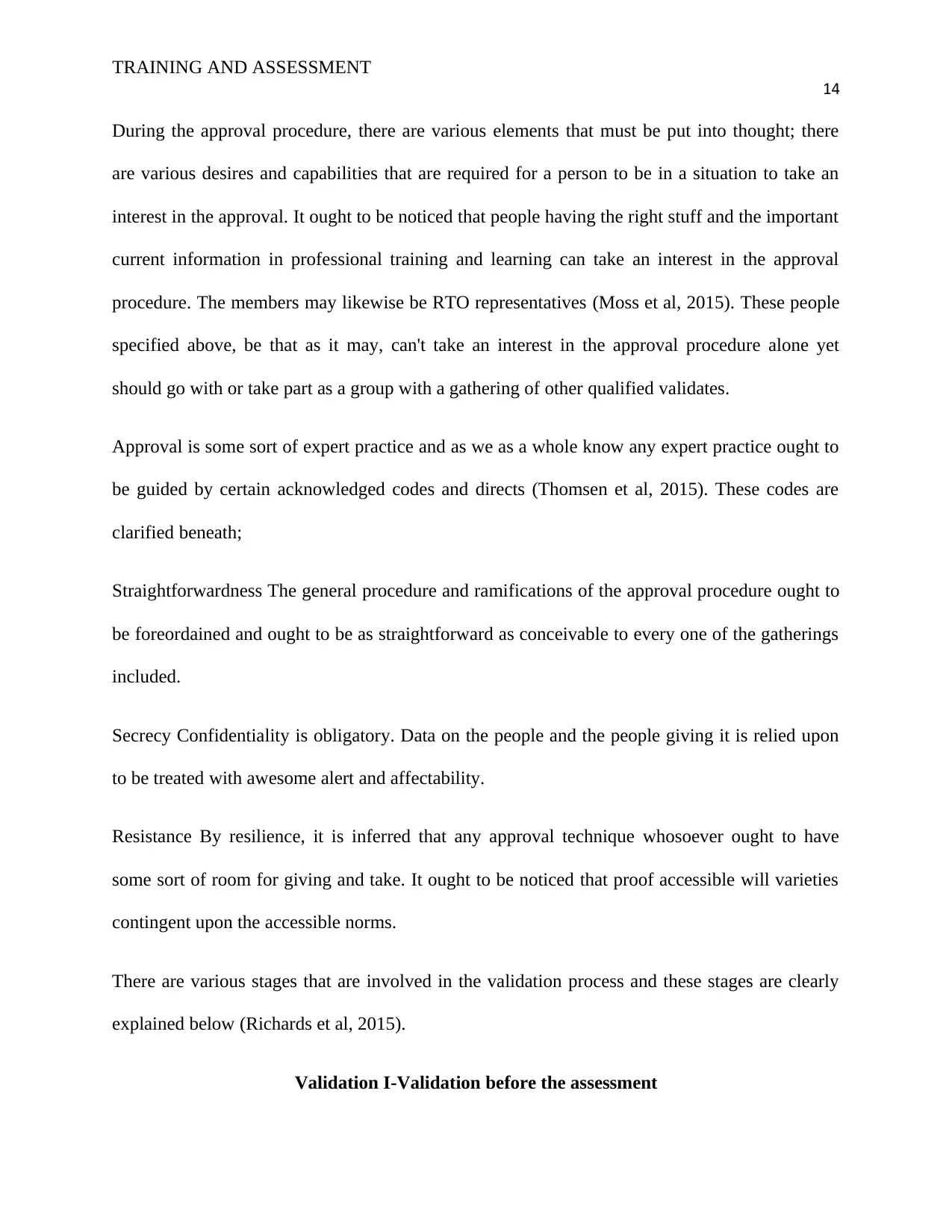
TRAINING AND ASSESSMENT
14
During the approval procedure, there are various elements that must be put into thought; there
are various desires and capabilities that are required for a person to be in a situation to take an
interest in the approval. It ought to be noticed that people having the right stuff and the important
current information in professional training and learning can take an interest in the approval
procedure. The members may likewise be RTO representatives (Moss et al, 2015). These people
specified above, be that as it may, can't take an interest in the approval procedure alone yet
should go with or take part as a group with a gathering of other qualified validates.
Approval is some sort of expert practice and as we as a whole know any expert practice ought to
be guided by certain acknowledged codes and directs (Thomsen et al, 2015). These codes are
clarified beneath;
Straightforwardness The general procedure and ramifications of the approval procedure ought to
be foreordained and ought to be as straightforward as conceivable to every one of the gatherings
included.
Secrecy Confidentiality is obligatory. Data on the people and the people giving it is relied upon
to be treated with awesome alert and affectability.
Resistance By resilience, it is inferred that any approval technique whosoever ought to have
some sort of room for giving and take. It ought to be noticed that proof accessible will varieties
contingent upon the accessible norms.
There are various stages that are involved in the validation process and these stages are clearly
explained below (Richards et al, 2015).
Validation I-Validation before the assessment
14
During the approval procedure, there are various elements that must be put into thought; there
are various desires and capabilities that are required for a person to be in a situation to take an
interest in the approval. It ought to be noticed that people having the right stuff and the important
current information in professional training and learning can take an interest in the approval
procedure. The members may likewise be RTO representatives (Moss et al, 2015). These people
specified above, be that as it may, can't take an interest in the approval procedure alone yet
should go with or take part as a group with a gathering of other qualified validates.
Approval is some sort of expert practice and as we as a whole know any expert practice ought to
be guided by certain acknowledged codes and directs (Thomsen et al, 2015). These codes are
clarified beneath;
Straightforwardness The general procedure and ramifications of the approval procedure ought to
be foreordained and ought to be as straightforward as conceivable to every one of the gatherings
included.
Secrecy Confidentiality is obligatory. Data on the people and the people giving it is relied upon
to be treated with awesome alert and affectability.
Resistance By resilience, it is inferred that any approval technique whosoever ought to have
some sort of room for giving and take. It ought to be noticed that proof accessible will varieties
contingent upon the accessible norms.
There are various stages that are involved in the validation process and these stages are clearly
explained below (Richards et al, 2015).
Validation I-Validation before the assessment
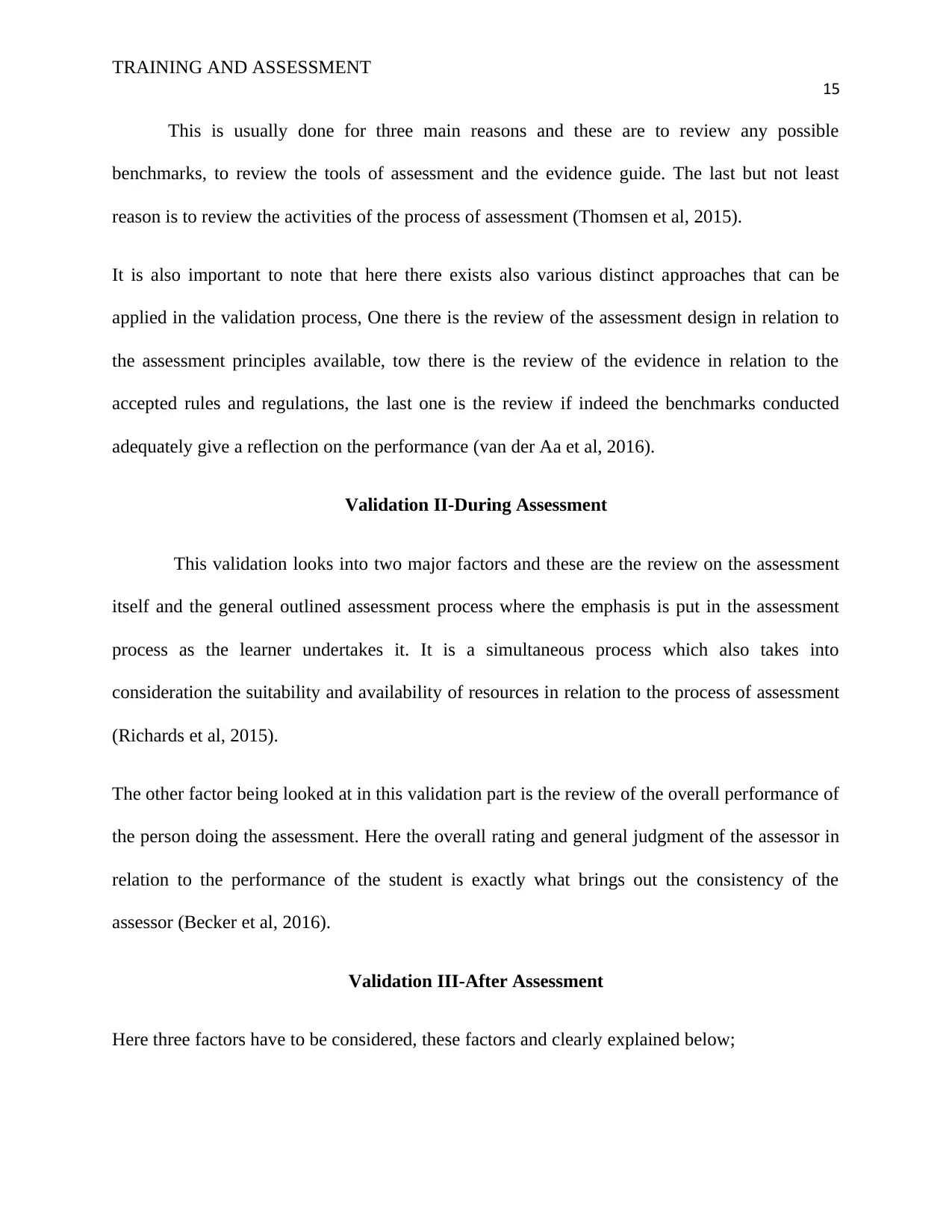
TRAINING AND ASSESSMENT
15
This is usually done for three main reasons and these are to review any possible
benchmarks, to review the tools of assessment and the evidence guide. The last but not least
reason is to review the activities of the process of assessment (Thomsen et al, 2015).
It is also important to note that here there exists also various distinct approaches that can be
applied in the validation process, One there is the review of the assessment design in relation to
the assessment principles available, tow there is the review of the evidence in relation to the
accepted rules and regulations, the last one is the review if indeed the benchmarks conducted
adequately give a reflection on the performance (van der Aa et al, 2016).
Validation II-During Assessment
This validation looks into two major factors and these are the review on the assessment
itself and the general outlined assessment process where the emphasis is put in the assessment
process as the learner undertakes it. It is a simultaneous process which also takes into
consideration the suitability and availability of resources in relation to the process of assessment
(Richards et al, 2015).
The other factor being looked at in this validation part is the review of the overall performance of
the person doing the assessment. Here the overall rating and general judgment of the assessor in
relation to the performance of the student is exactly what brings out the consistency of the
assessor (Becker et al, 2016).
Validation III-After Assessment
Here three factors have to be considered, these factors and clearly explained below;
15
This is usually done for three main reasons and these are to review any possible
benchmarks, to review the tools of assessment and the evidence guide. The last but not least
reason is to review the activities of the process of assessment (Thomsen et al, 2015).
It is also important to note that here there exists also various distinct approaches that can be
applied in the validation process, One there is the review of the assessment design in relation to
the assessment principles available, tow there is the review of the evidence in relation to the
accepted rules and regulations, the last one is the review if indeed the benchmarks conducted
adequately give a reflection on the performance (van der Aa et al, 2016).
Validation II-During Assessment
This validation looks into two major factors and these are the review on the assessment
itself and the general outlined assessment process where the emphasis is put in the assessment
process as the learner undertakes it. It is a simultaneous process which also takes into
consideration the suitability and availability of resources in relation to the process of assessment
(Richards et al, 2015).
The other factor being looked at in this validation part is the review of the overall performance of
the person doing the assessment. Here the overall rating and general judgment of the assessor in
relation to the performance of the student is exactly what brings out the consistency of the
assessor (Becker et al, 2016).
Validation III-After Assessment
Here three factors have to be considered, these factors and clearly explained below;
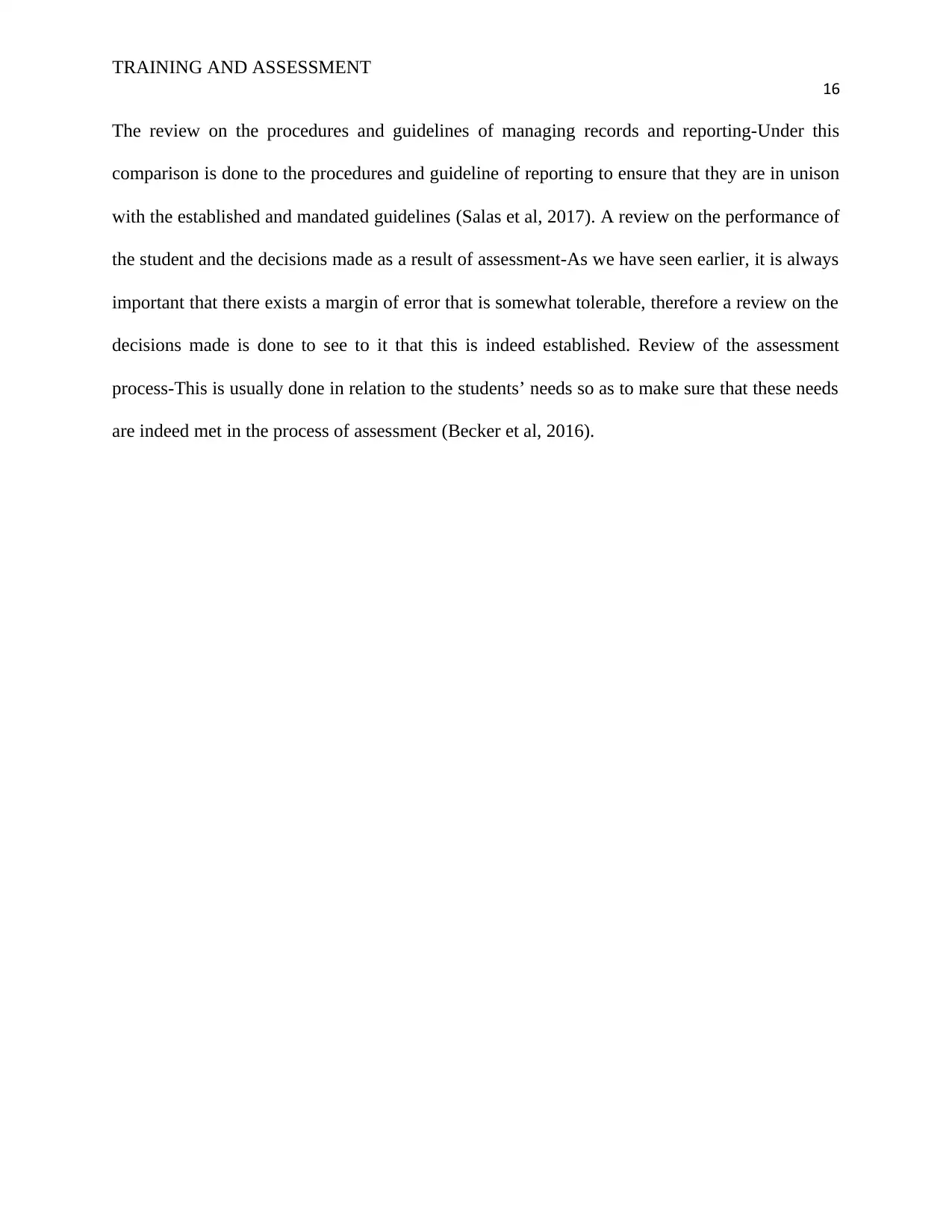
TRAINING AND ASSESSMENT
16
The review on the procedures and guidelines of managing records and reporting-Under this
comparison is done to the procedures and guideline of reporting to ensure that they are in unison
with the established and mandated guidelines (Salas et al, 2017). A review on the performance of
the student and the decisions made as a result of assessment-As we have seen earlier, it is always
important that there exists a margin of error that is somewhat tolerable, therefore a review on the
decisions made is done to see to it that this is indeed established. Review of the assessment
process-This is usually done in relation to the students’ needs so as to make sure that these needs
are indeed met in the process of assessment (Becker et al, 2016).
16
The review on the procedures and guidelines of managing records and reporting-Under this
comparison is done to the procedures and guideline of reporting to ensure that they are in unison
with the established and mandated guidelines (Salas et al, 2017). A review on the performance of
the student and the decisions made as a result of assessment-As we have seen earlier, it is always
important that there exists a margin of error that is somewhat tolerable, therefore a review on the
decisions made is done to see to it that this is indeed established. Review of the assessment
process-This is usually done in relation to the students’ needs so as to make sure that these needs
are indeed met in the process of assessment (Becker et al, 2016).
Secure Best Marks with AI Grader
Need help grading? Try our AI Grader for instant feedback on your assignments.
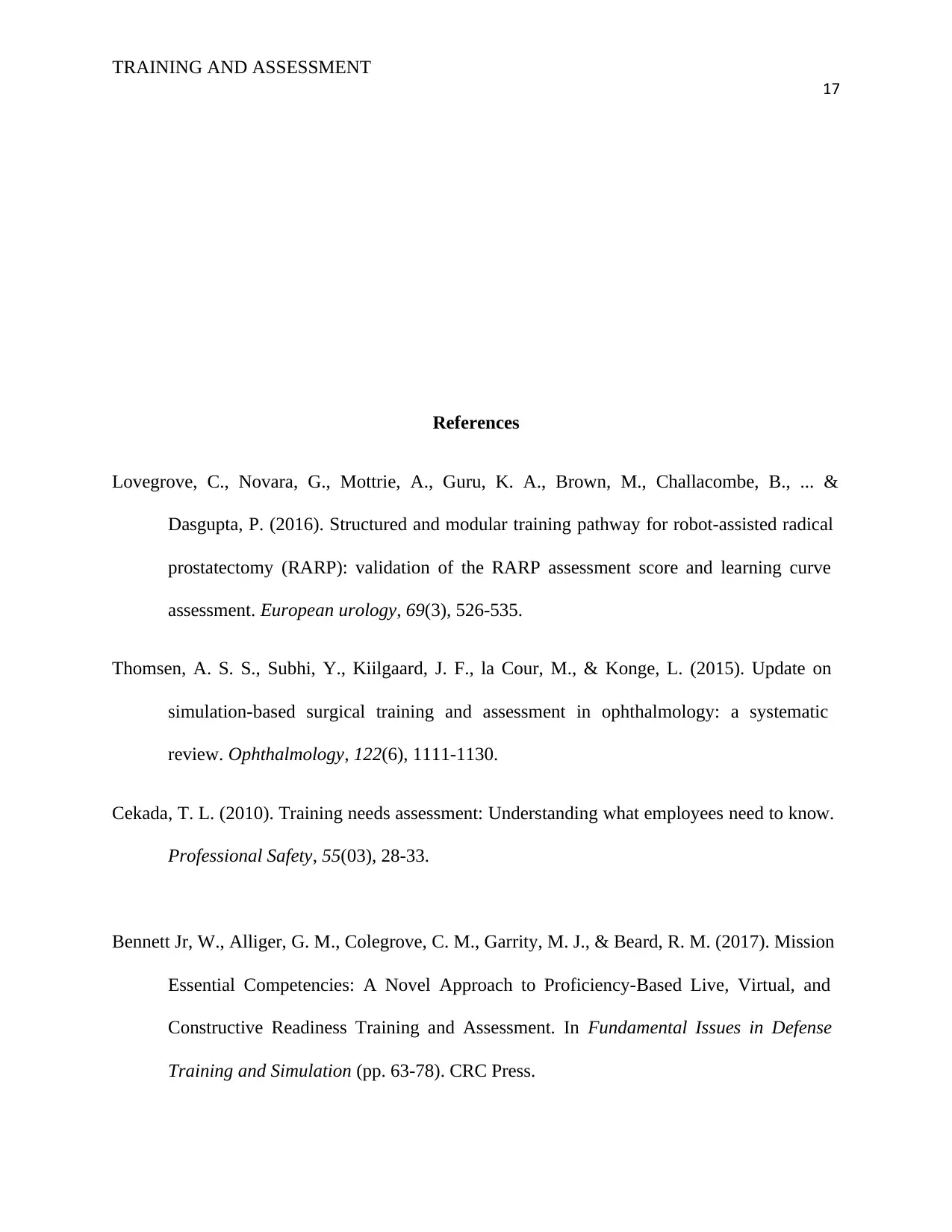
TRAINING AND ASSESSMENT
17
References
Lovegrove, C., Novara, G., Mottrie, A., Guru, K. A., Brown, M., Challacombe, B., ... &
Dasgupta, P. (2016). Structured and modular training pathway for robot-assisted radical
prostatectomy (RARP): validation of the RARP assessment score and learning curve
assessment. European urology, 69(3), 526-535.
Thomsen, A. S. S., Subhi, Y., Kiilgaard, J. F., la Cour, M., & Konge, L. (2015). Update on
simulation-based surgical training and assessment in ophthalmology: a systematic
review. Ophthalmology, 122(6), 1111-1130.
Cekada, T. L. (2010). Training needs assessment: Understanding what employees need to know.
Professional Safety, 55(03), 28-33.
Bennett Jr, W., Alliger, G. M., Colegrove, C. M., Garrity, M. J., & Beard, R. M. (2017). Mission
Essential Competencies: A Novel Approach to Proficiency-Based Live, Virtual, and
Constructive Readiness Training and Assessment. In Fundamental Issues in Defense
Training and Simulation (pp. 63-78). CRC Press.
17
References
Lovegrove, C., Novara, G., Mottrie, A., Guru, K. A., Brown, M., Challacombe, B., ... &
Dasgupta, P. (2016). Structured and modular training pathway for robot-assisted radical
prostatectomy (RARP): validation of the RARP assessment score and learning curve
assessment. European urology, 69(3), 526-535.
Thomsen, A. S. S., Subhi, Y., Kiilgaard, J. F., la Cour, M., & Konge, L. (2015). Update on
simulation-based surgical training and assessment in ophthalmology: a systematic
review. Ophthalmology, 122(6), 1111-1130.
Cekada, T. L. (2010). Training needs assessment: Understanding what employees need to know.
Professional Safety, 55(03), 28-33.
Bennett Jr, W., Alliger, G. M., Colegrove, C. M., Garrity, M. J., & Beard, R. M. (2017). Mission
Essential Competencies: A Novel Approach to Proficiency-Based Live, Virtual, and
Constructive Readiness Training and Assessment. In Fundamental Issues in Defense
Training and Simulation (pp. 63-78). CRC Press.
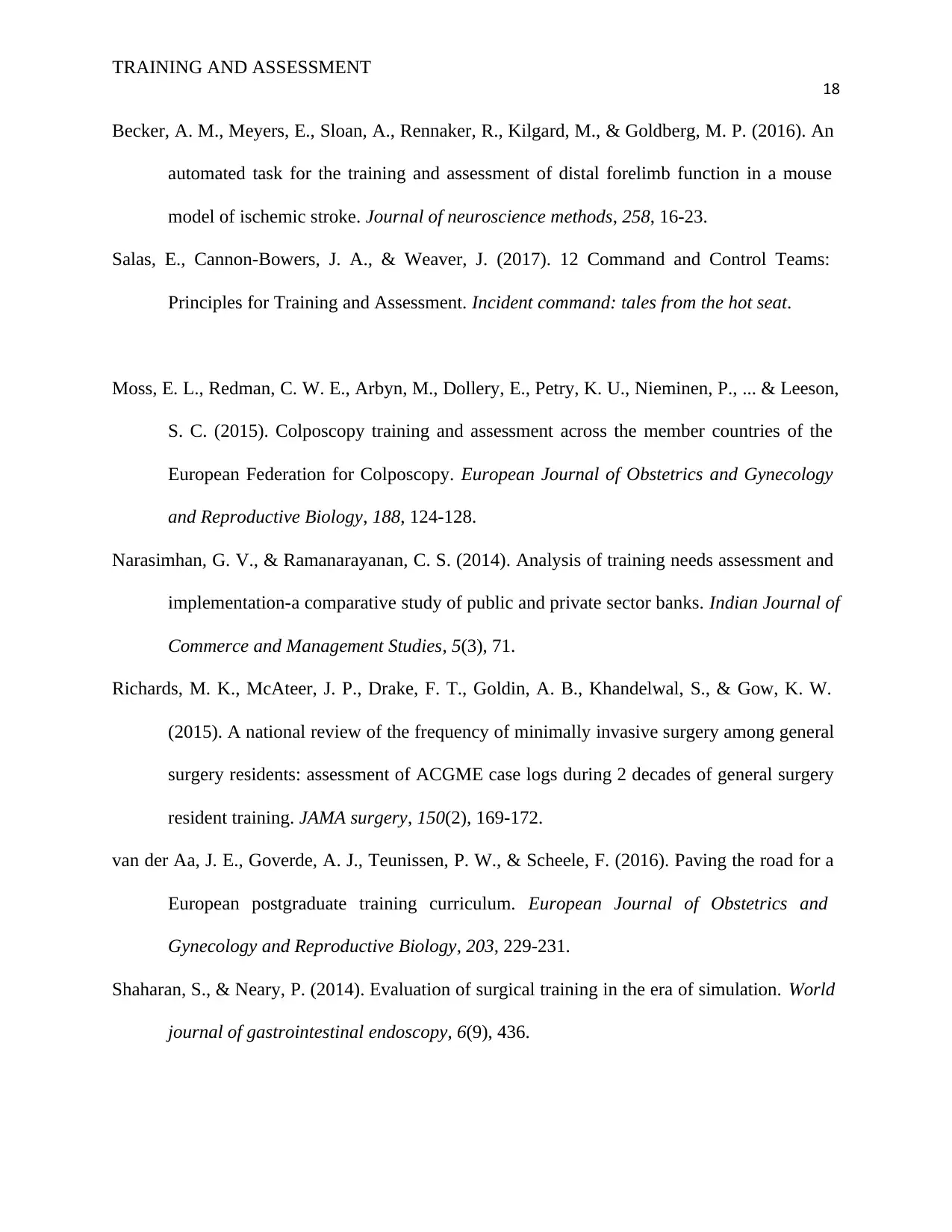
TRAINING AND ASSESSMENT
18
Becker, A. M., Meyers, E., Sloan, A., Rennaker, R., Kilgard, M., & Goldberg, M. P. (2016). An
automated task for the training and assessment of distal forelimb function in a mouse
model of ischemic stroke. Journal of neuroscience methods, 258, 16-23.
Salas, E., Cannon-Bowers, J. A., & Weaver, J. (2017). 12 Command and Control Teams:
Principles for Training and Assessment. Incident command: tales from the hot seat.
Moss, E. L., Redman, C. W. E., Arbyn, M., Dollery, E., Petry, K. U., Nieminen, P., ... & Leeson,
S. C. (2015). Colposcopy training and assessment across the member countries of the
European Federation for Colposcopy. European Journal of Obstetrics and Gynecology
and Reproductive Biology, 188, 124-128.
Narasimhan, G. V., & Ramanarayanan, C. S. (2014). Analysis of training needs assessment and
implementation-a comparative study of public and private sector banks. Indian Journal of
Commerce and Management Studies, 5(3), 71.
Richards, M. K., McAteer, J. P., Drake, F. T., Goldin, A. B., Khandelwal, S., & Gow, K. W.
(2015). A national review of the frequency of minimally invasive surgery among general
surgery residents: assessment of ACGME case logs during 2 decades of general surgery
resident training. JAMA surgery, 150(2), 169-172.
van der Aa, J. E., Goverde, A. J., Teunissen, P. W., & Scheele, F. (2016). Paving the road for a
European postgraduate training curriculum. European Journal of Obstetrics and
Gynecology and Reproductive Biology, 203, 229-231.
Shaharan, S., & Neary, P. (2014). Evaluation of surgical training in the era of simulation. World
journal of gastrointestinal endoscopy, 6(9), 436.
18
Becker, A. M., Meyers, E., Sloan, A., Rennaker, R., Kilgard, M., & Goldberg, M. P. (2016). An
automated task for the training and assessment of distal forelimb function in a mouse
model of ischemic stroke. Journal of neuroscience methods, 258, 16-23.
Salas, E., Cannon-Bowers, J. A., & Weaver, J. (2017). 12 Command and Control Teams:
Principles for Training and Assessment. Incident command: tales from the hot seat.
Moss, E. L., Redman, C. W. E., Arbyn, M., Dollery, E., Petry, K. U., Nieminen, P., ... & Leeson,
S. C. (2015). Colposcopy training and assessment across the member countries of the
European Federation for Colposcopy. European Journal of Obstetrics and Gynecology
and Reproductive Biology, 188, 124-128.
Narasimhan, G. V., & Ramanarayanan, C. S. (2014). Analysis of training needs assessment and
implementation-a comparative study of public and private sector banks. Indian Journal of
Commerce and Management Studies, 5(3), 71.
Richards, M. K., McAteer, J. P., Drake, F. T., Goldin, A. B., Khandelwal, S., & Gow, K. W.
(2015). A national review of the frequency of minimally invasive surgery among general
surgery residents: assessment of ACGME case logs during 2 decades of general surgery
resident training. JAMA surgery, 150(2), 169-172.
van der Aa, J. E., Goverde, A. J., Teunissen, P. W., & Scheele, F. (2016). Paving the road for a
European postgraduate training curriculum. European Journal of Obstetrics and
Gynecology and Reproductive Biology, 203, 229-231.
Shaharan, S., & Neary, P. (2014). Evaluation of surgical training in the era of simulation. World
journal of gastrointestinal endoscopy, 6(9), 436.
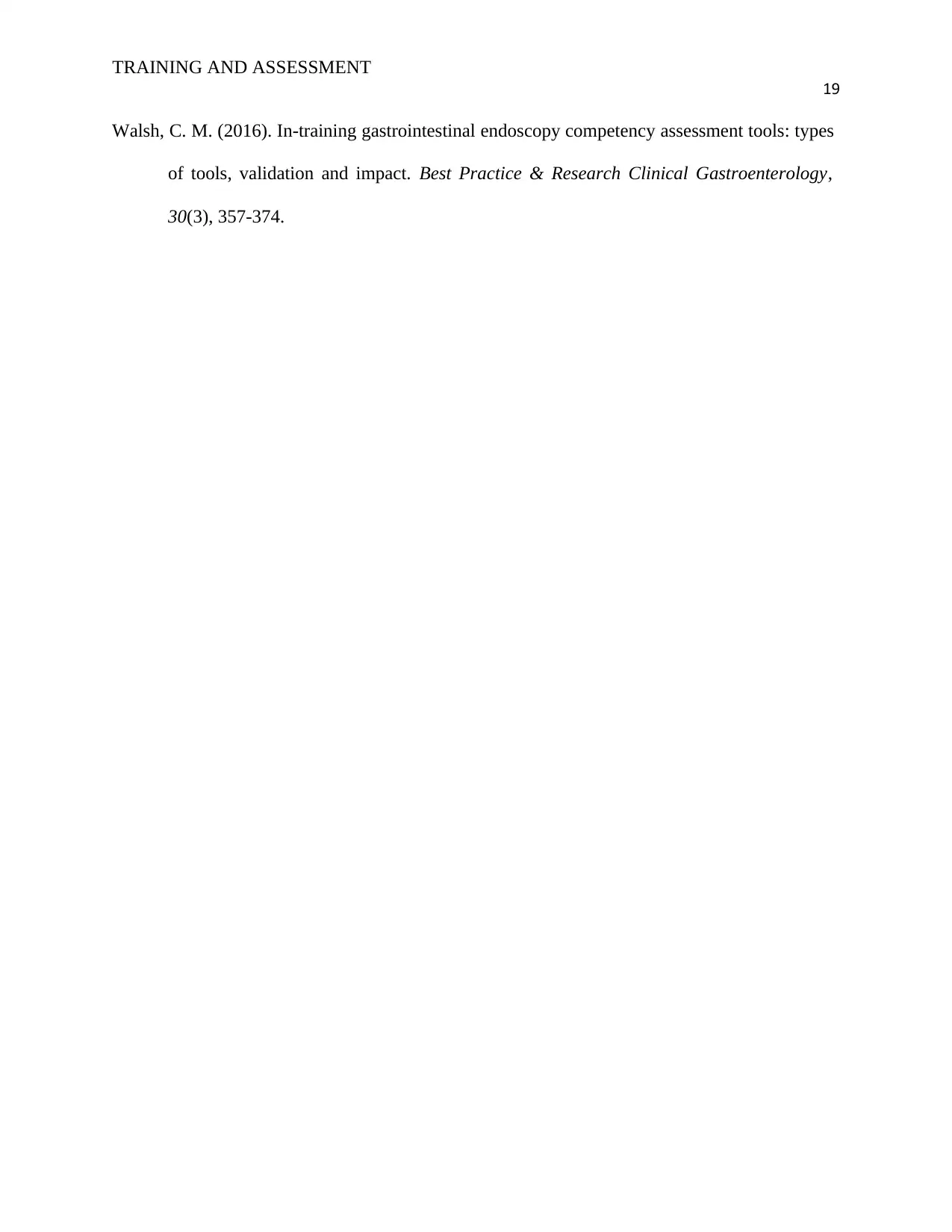
TRAINING AND ASSESSMENT
19
Walsh, C. M. (2016). In-training gastrointestinal endoscopy competency assessment tools: types
of tools, validation and impact. Best Practice & Research Clinical Gastroenterology,
30(3), 357-374.
19
Walsh, C. M. (2016). In-training gastrointestinal endoscopy competency assessment tools: types
of tools, validation and impact. Best Practice & Research Clinical Gastroenterology,
30(3), 357-374.
1 out of 19
Your All-in-One AI-Powered Toolkit for Academic Success.
+13062052269
info@desklib.com
Available 24*7 on WhatsApp / Email
![[object Object]](/_next/static/media/star-bottom.7253800d.svg)
Unlock your academic potential
© 2024 | Zucol Services PVT LTD | All rights reserved.
